Martin Luther King Essay for Students and Children
500+ words essay on martin luter king.
Martin Luther King Jr. was an African-American leader in the U.S. He lost his life while performing a peaceful protest for the betterment of blacks in America. His real name was Michael King Jr. He completed his studies and attained a Ph.D. After that, he joined the American Civil Right Movement. He was among one of the great men who dedicated their life for the community.


Reason for Martin Luther King to be famous
There are two reasons for someone to be famous either he is a good man or a very bad person. Martin Luther King was among the good one who dedicated his life to the community. Martin Luther King was also known as MLK Jr. He gained popularity after he became the leader and spokesperson of the Civil Rights Movement in the 1950s and 1960s.
Martin Luther King was an American activist, minister, and humanitarian. Also, he had worked for several other causes and actively participated in many protests and boycotts. He was a peaceful man that has faith in Christian beliefs and non-violence. Also, his inspiration for them was the work of Mahatma Gandhi and Nelson Mandela. For his work in the field of civil rights, the Nobel Committee awarded him the Nobel Peace Prize.
He was a great speaker that motivated the blacks to protest using non-violence. Also, he uses peaceful strategies like a boycott, protest march , and sit-ins, etc. for protests against the government.
Impact of King
King is one of the renowned leaders of the African-American who worked for the welfare of his community throughout his life. He was very famous among the community and is the strongest voice of the community. King and his fellow companies and peaceful protesters forced the government several times to bend their laws. Also, kings’ life made a seismic impact on life and thinking of the blacks. He was among one of the great leaders of the era.
Get the huge list of more than 500 Essay Topics and Ideas
Humanitarian and civil rights work
As we know that King was a civic leader . Also, he has taken part in many civil right campaigns and boycotts like the Bus Boycott, Voting Rights and the most famous March on Washington. In this march along with more than 200,000 people, he marched towards Washington for human right. Also, it’s the largest human right campaign in U.S.A. history. During the protest, he gave a speech named “I Have a Dream” which is history’s one of the renowned speeches.
Death and memorial
During his life working as a leader of the Civil Rights Movement he makes many enemies. Also, the government and plans do everything to hurt his reputation. Martin Luther King was assassinated in 1968. Every year the US celebrates his anniversary as Martin Luther King Jr. day in the US. Also, they honored kings’ memory by naming school and building after him and a Memorial at Independence Mall.
Martin Luther King was a great man who dedicated his whole life for his community. Also, he was an active leader and a great spokesperson that not only served his people but also humanity. It was due to his contribution that the African-American got their civil rights.
Essay Topics on Famous Leaders
- Mahatma Gandhi
- APJ Abdul Kalam
- Jawaharlal Nehru
- Swami Vivekananda
- Mother Teresa
- Rabindranath Tagore
- Sardar Vallabhbhai Patel
- Subhash Chandra Bose
- Abraham Lincoln
- Martin Luther King
Customize your course in 30 seconds
Which class are you in.

- Travelling Essay
- Picnic Essay
- Our Country Essay
- My Parents Essay
- Essay on Favourite Personality
- Essay on Memorable Day of My Life
- Essay on Knowledge is Power
- Essay on Gurpurab
- Essay on My Favourite Season
- Essay on Types of Sports
Leave a Reply Cancel reply
Your email address will not be published. Required fields are marked *
Download the App

Martin Luther King Jr.
Martin Luther King Jr. was a Baptist minister and major leader of the Civil Rights Movement. After his assassination, he was memorialized by Martin Luther King Jr. Day.

We may earn commission from links on this page, but we only recommend products we back.
In Focus: Martin Luther King Jr. Day
Days after his 1968 assassination , a campaign for a holiday in King’s honor began. U.S. Representative John Conyers Jr. of Michigan first proposed a bill on April 8, 1968, but the first vote on the legislation didn’t happen until 1979. King’s widow, Coretta Scott King , led the lobbying effort to drum up public support. Fifteen years after its introduction, the bill finally became law.
In 1983, President Ronald Reagan ’s signature created Martin Luther King Jr. Day of Service as a federal holiday. It’s celebrated annually on the third Monday in January. The only national day of service, Martin Luther King Jr. Day was first celebrated in 1986. The first time all 50 states recognized the holiday was in 2000.
See Martin Luther King Jr.’s life depicted onscreen in the 2018 documentary I Am MLK Jr. or the Oscar-winning movie Selma .
Quick Facts
Where did martin luther king jr. go to school, philosophy of nonviolence, civil rights accomplishments, "i have a dream" and other famous speeches, wife and kids, fbi surveillance, later activism, assassination, who was martin luther king jr.
Martin Luther King Jr. was a Baptist minister and civil rights activist who had a seismic impact on race relations in the United States, beginning in the mid-1950s. Among his many efforts, King headed the Southern Christian Leadership Conference (SCLC). Through his nonviolent activism and inspirational speeches , he played a pivotal role in ending legal segregation of Black Americans, as well as the creation of the Civil Rights Act of 1964 and the Voting Rights Act of 1965 . King won the Nobel Peace Prize in 1964, among several other honors. He was assassinated by James Earl Ray and died on April 4, 1968, at age 39. King continues to be remembered as one of the most influential and inspirational Black leaders in history.
FULL NAME: Martin Luther King Jr. BIRTHDAY: January 15, 1929 DIED: April 4, 1968 BIRTHPLACE: Atlanta, Georgia SPOUSE: Coretta Scott King (1953-1968) CHILDREN: Yolanda, Martin III, Dexter, and Bernice King ASTROLOGICAL SIGN: Capricorn
Martin Luther King Jr. was born as Michael Luther King Jr. in Atlanta. His birthday was January 15, 1929.

His parents were Michael Luther King Sr. and Alberta Williams King. The Williams and King families had roots in rural Georgia. Martin’s maternal grandfather, A.D. Williams, was a rural minister for years and then moved to Atlanta in 1893. He took over the small, struggling Ebenezer Baptist Church with around 13 members and made it into a forceful congregation. He married Jennie Celeste Parks, and they had one child who survived, Alberta.
Michael Sr. came from a family of sharecroppers in a poor farming community. He married Alberta in 1926 after an eight-year courtship. The newlyweds moved to A.D.’s home in Atlanta. Michael stepped in as pastor of Ebenezer Baptist Church upon the death of his father-in-law in 1931. He, too, became a successful minister and adopted the name Martin Luther King Sr. in honor of the German Protestant religious leader Martin Luther . In due time, Michael Jr. followed his father’s lead and adopt the name himself to become Martin Luther King Jr.
A middle child, Martin Jr. had an older sister, Willie, and a younger brother, Alfred. The King children grew up in a secure and loving environment. Martin Sr. was more the disciplinarian, while Alberta’s gentleness easily balanced out their father’s strict hand.
Although they undoubtedly tried, Martin Jr.’s parents couldn’t shield him completely from racism. His father fought against racial prejudice, not just because his race suffered, but also because he considered racism and segregation to be an affront to God’s will. He strongly discouraged any sense of class superiority in his children, which left a lasting impression on Martin Jr.
Growing up in Atlanta, King entered public school at age 5. In May 1936, he was baptized, but the event made little impression on him.
In May 1941, King was 12 years old when his grandmother Jennie died of a heart attack. The event was traumatic for the boy, more so because he was out watching a parade against his parents’ wishes when she died. Distraught at the news, young King jumped from a second-story window at the family home, allegedly attempting suicide.
King attended Booker T. Washington High School, where he was said to be a precocious student. He skipped both the ninth and eleventh grades and, at age 15, entered Morehouse College in Atlanta in 1944. He was a popular student, especially with his female classmates, but largely unmotivated, floating through his first two years.
Influenced by his experiences with racism, King began planting the seeds for a future as a social activist early in his time at Morehouse. “I was at the point where I was deeply interested in political matters and social ills,” he recalled in The Autobiography of Martin Luther King, Jr . “I could envision myself playing a part in breaking down the legal barriers to Negro rights.”
The Autobiography of Martin Luther King, Jr.
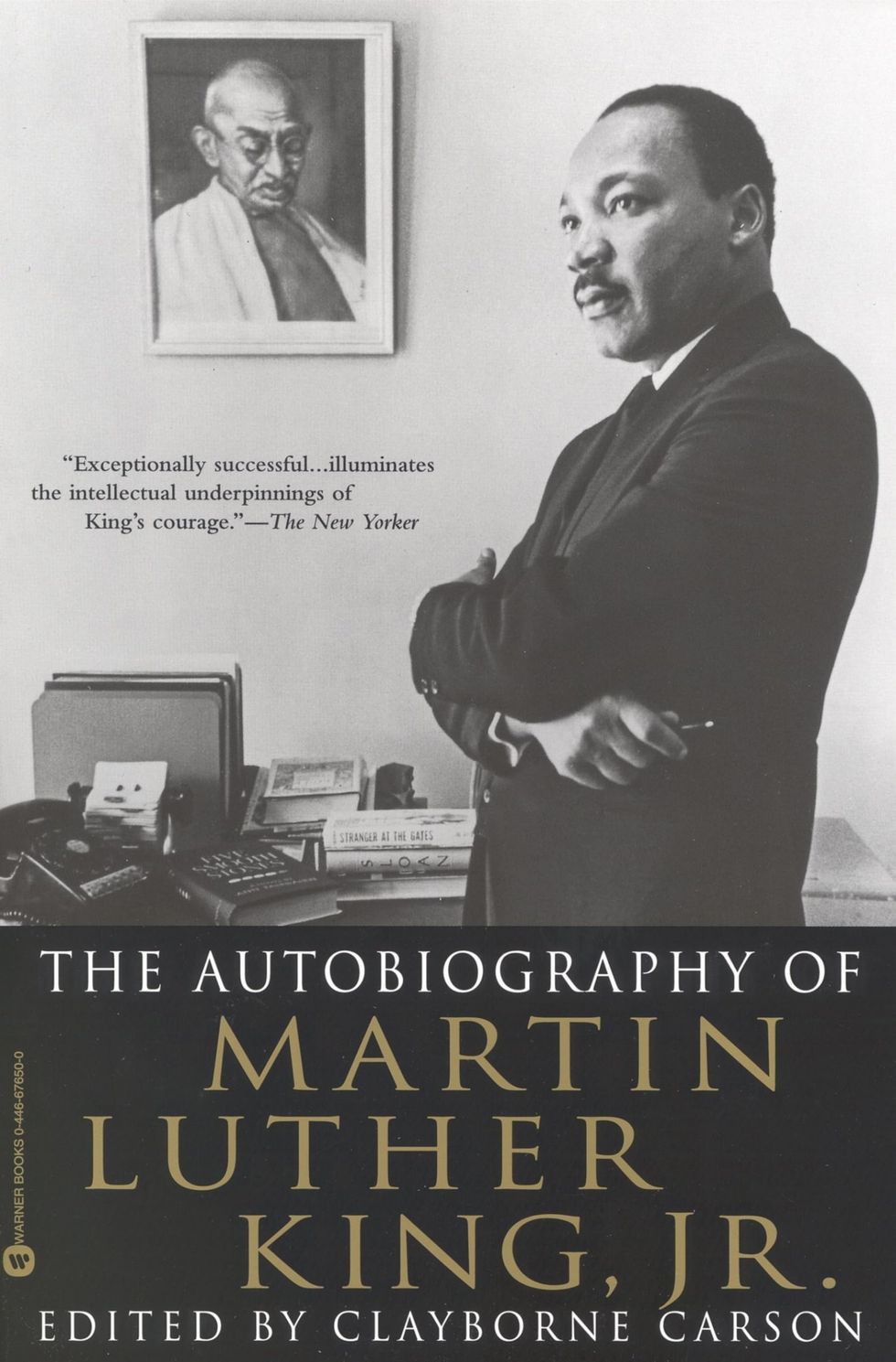
At the time, King felt that the best way to serve that purpose was as a lawyer or a doctor. Although his family was deeply involved in the church and worship, King questioned religion in general and felt uncomfortable with overly emotional displays of religious worship. This discomfort had continued through much of his adolescence, initially leading him to decide against entering the ministry, much to his father’s dismay.
But in his junior year, King took a Bible class, renewed his faith, and began to envision a career in the ministry. In the fall of his senior year, he told his father of his decision, and he was ordained at Ebenezer Baptist Church in February 1948.
Later that year, King earned a sociology degree from Morehouse College and began attended the liberal Crozer Theological Seminary in Chester, Pennsylvania. He thrived in all his studies, was elected student body president, and was valedictorian of his class in 1951. He also earned a fellowship for graduate study.
Even though King was following his father’s footsteps, he rebelled against Martin Sr.’s more conservative influence by drinking beer and playing pool while at college. He became romantically involved with a white woman and went through a difficult time before he could break off the relationship.
During his last year in seminary, King came under the guidance of Morehouse College President Benjamin E. Mays, who influenced King’s spiritual development. Mays was an outspoken advocate for racial equality and encouraged King to view Christianity as a potential force for social change.
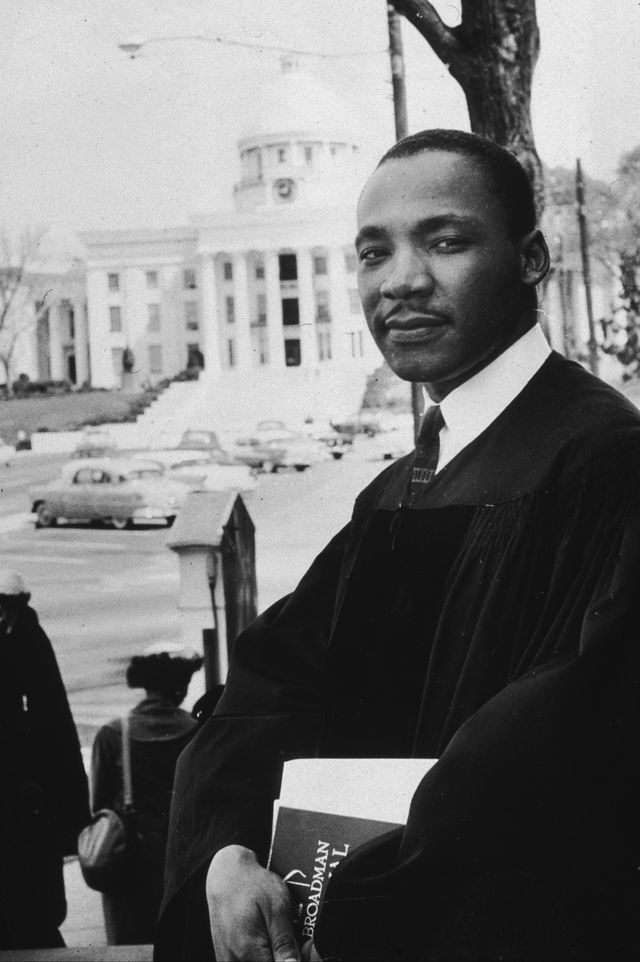
After being accepted at several colleges for his doctoral study, King enrolled at Boston University. In 1954, while still working on his dissertation, King became pastor of the Dexter Avenue Baptist Church of Montgomery, Alabama. He completed his doctorate and earned his degree in 1955 at age 25.
Decades after King’s death, in the late 1980s, researchers at Stanford University’s King Papers Project began to note similarities between passages of King’s doctoral dissertation and those of another student’s work. A committee of scholars appointed by Boston University determined that King was guilty of plagiarism in 1991, though it also recommended against the revocation of his degree.
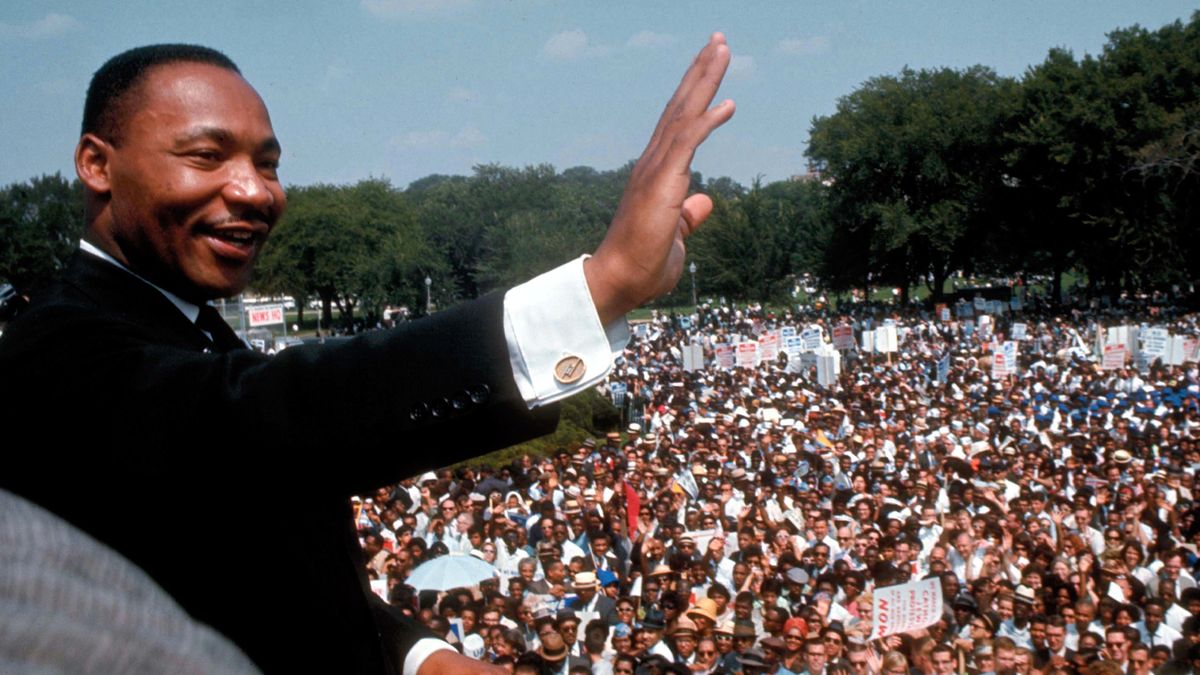
First exposed to the concept of nonviolent resistance while reading Henry David Thoreau ’s On Civil Disobedience at Morehouse, King later discovered a powerful exemplar of the method’s possibilities through his research into the life of Mahatma Gandhi . Fellow civil rights activist Bayard Rustin , who had also studied Gandhi’s teachings, became one of King’s associates in the 1950s and counseled him to dedicate himself to the principles of nonviolence.
As explained in his autobiography , King previously felt that the peaceful teachings of Jesus applied mainly to individual relationships, not large-scale confrontations. But he came to realize: “Love for Gandhi was a potent instrument for social and collective transformation. It was in this Gandhian emphasis on love and nonviolence that I discovered the method for social reform that I had been seeking.”
It led to the formation of King’s six principles of nonviolence :
- Nonviolence is a way of life for courageous people.
- Nonviolence seeks to win friendship and understanding.
- Nonviolence seeks to defeat injustice, not people.
- Nonviolence holds that suffering for a just cause can educate and transform.
- Nonviolence chooses love instead of hate.
- Nonviolence believes that the universe is on the side of justice.
In the years to come, King also frequently cited the “ Beloved Community ”—a world in which a shared spirit of compassion brings an end to the evils of racism, poverty, inequality, and violence—as the end goal of his activist efforts.

Led by his religious convictions and philosophy of nonviolence, King became one of the most prominent figures of the Civil Rights Movement . He was a founding member of the Southern Christian Leadership Conference and played key roles in several major demonstrations that transformed society. This included the Montgomery Bus Boycott that integrated Alabama’s public transit, the Greensboro Sit-In movement that desegregated lunch counters across the South, the March on Washington that led to the passage of the 1964 Civil Rights Act, and the Selma-to-Montgomery marches in Alabama that culminated in the 1965 Voting Rights Act.
King’s efforts earned him the Nobel Peace Prize in 1964 when he was 35.
Montgomery Bus Boycott
King’s first leadership role within the Civil Rights Movement was during the Montgomery Bus Boycott of 1955–1956. The 381-day protest integrated the Alabama city’s public transit in one of the largest and most successful mass movements against racial segregation in history.
The effort began on December 1, 1955, when 42-year-old Rosa Parks boarded the Cleveland Avenue bus to go home after an exhausting day at work. She sat in the first row of the “colored” section in the middle of the bus. As the bus traveled its route, all the seats in the white section filled up, then several more white passengers boarded the bus.
The bus driver noted that there were several white men standing and demanded that Parks and several other African Americans give up their seats. Three other Black passengers reluctantly gave up their places, but Parks remained seated.
The driver asked her again to give up her seat, and again she refused. Parks was arrested and booked for violating the Montgomery City Code. At her trial a week later, in a 30-minute hearing, Parks was found guilty and fined $10 and assessed $4 court fee.
The local NAACP chapter had been looking to challenge Montgomery’s segregated bus policy and had almost made 15-year-old Claudette Colvin the face of the campaign months earlier. She similarly refused to give up her bus seat to a white man on March 2, 1955, but after organizers learned Colvin was pregnant, they feared it would scandalize the deeply religious Black community and make Colvin, along with the group’s efforts, less credible in the eyes of sympathetic white people. Parks’ experience of discrimination provided another opportunity.
On the night Parks was arrested, E.D. Nixon , head of the local NAACP chapter, met with King and other local civil rights leaders to plan a Montgomery Bus Boycott. King was elected to lead the boycott because he was young, well-trained, and had solid family connections and professional standing. He was also new to the community and had few enemies, so organizers felt he would have strong credibility with the Black community.
In his first speech as the group’s president, King declared:
“We have no alternative but to protest. For many years, we have shown an amazing patience. We have sometimes given our white brothers the feeling that we liked the way we were being treated. But we come here tonight to be saved from that patience that makes us patient with anything less than freedom and justice.”
King’s skillful rhetoric put new energy into the civil rights struggle in Alabama. The Montgomery Bus Boycott began December 5, 1955, and for more than a year, the local Black community walked to work, coordinated ride sharing, and faced harassment, violence, and intimidation. Both King’s and Nixon’s homes were attacked.
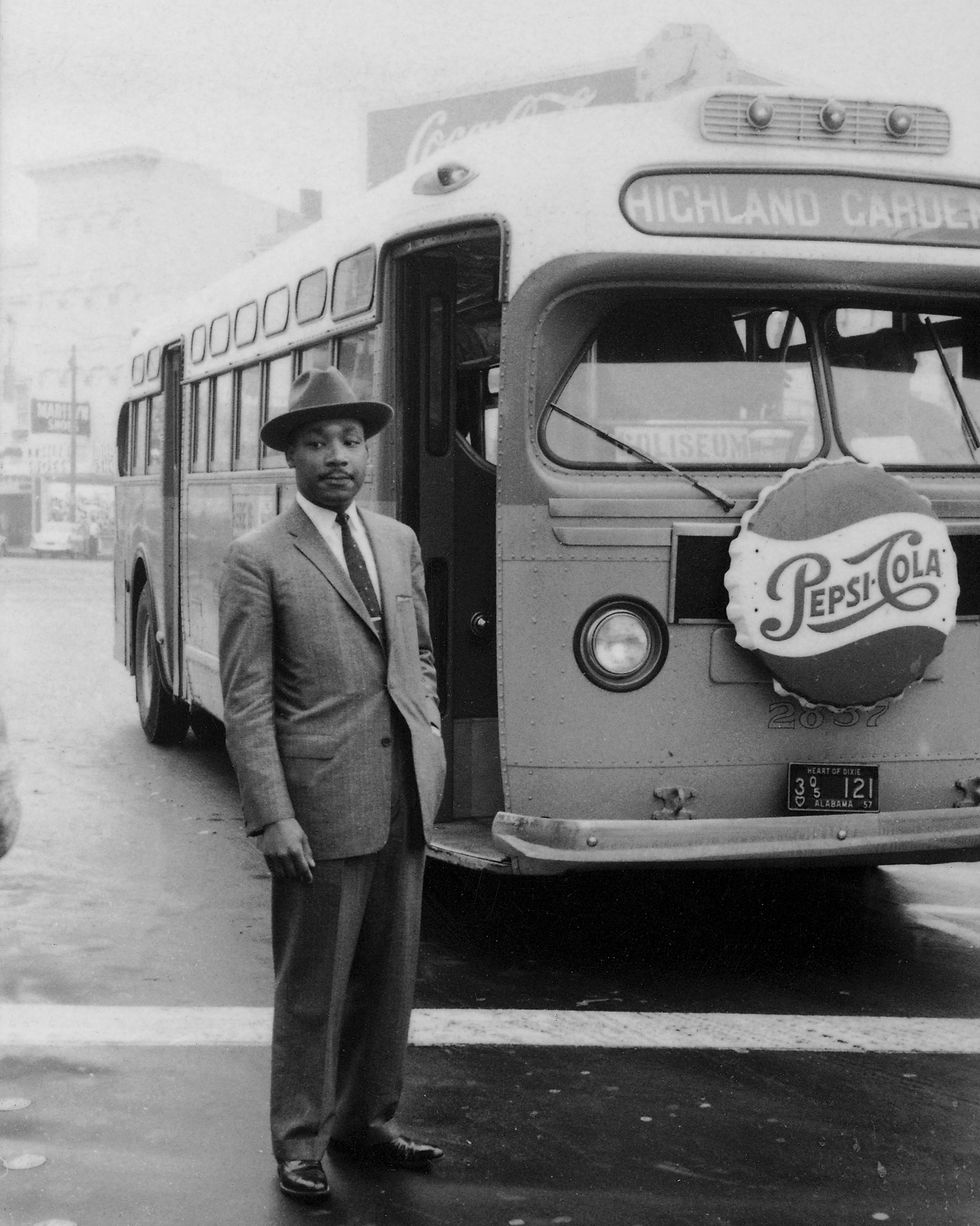
In addition to the boycott, members of the Black community took legal action against the city ordinance that outlined the segregated transit system. They argued it was unconstitutional based on the U.S. Supreme Court ’s “separate is never equal” decision in Brown v. Board of Education (1954). Several lower courts agreed, and the nation’s Supreme Court upheld the ruling in a November 13, 1956, decision that also ruled the state of Alabama’s bus segregation laws were unconstitutional.
After the legal defeats and large financial losses, the city of Montgomery lifted the law that mandated segregated public transportation. The boycott ended on December 20, 1956.
Southern Christian Leadership Conference
Flush with victory, African American civil rights leaders recognized the need for a national organization to help coordinate their efforts. In January 1957, King, Ralph Abernathy , and 60 ministers and civil rights activists founded the Southern Christian Leadership Conference to harness the moral authority and organizing power of Black churches. The SCLC helped conduct nonviolent protests to promote civil rights reform.
King’s participation in the organization gave him a base of operation throughout the South, as well as a national platform. The SCLC felt the best place to start to give African Americans a voice was to enfranchise them in the voting process. In February 1958, the SCLC sponsored more than 20 mass meetings in key southern cities to register Black voters. King met with religious and civil rights leaders and lectured all over the country on race-related issues.
Stride Toward Freedom: The Montgomery Story
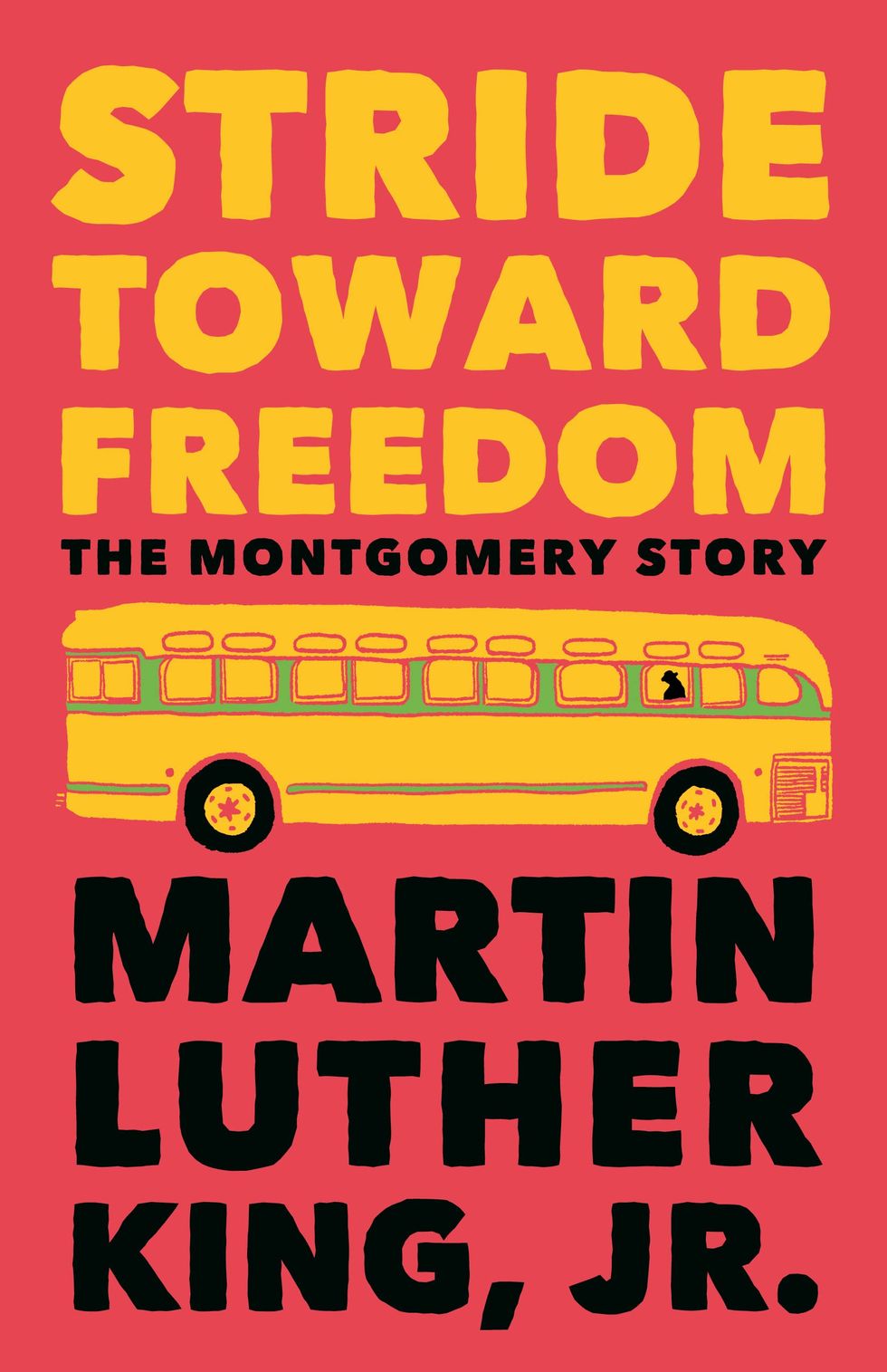
That September, King survived an attempt on his life when a woman with mental illness stabbed him in the chest as he signed copies of his book Stride Toward Freedom in a New York City department store. Saved by quick medical attention, King expressed sympathy for his assailant’s condition in the aftermath .
In 1959, with the help of the American Friends Service Committee, King visited Gandhi ’s birthplace in India. The trip affected him in a profound way, increasing his commitment to America’s civil rights struggle.
Greensboro Sit-In
By 1960, King was gaining national exposure. He returned to Atlanta to become co-pastor with his father at Ebenezer Baptist Church but also continued his civil rights efforts. His next activist campaign was the student-led Greensboro Sit-In movement.
In February 1960, a group of Black students in Greensboro, North Carolina , began sitting at racially segregated lunch counters in the city’s stores. When asked to leave or sit in the “colored” section, they just remained seated, subjecting themselves to verbal and sometimes physical abuse.
The movement quickly gained traction in several other cities. That April, the SCLC held a conference at Shaw University in Raleigh, North Carolina, with local sit-in leaders. King encouraged students to continue to use nonviolent methods during their protests. Out of this meeting, the Student Nonviolent Coordinating Committee (SNCC) formed and, for a time, worked closely with the SCLC. By August 1960, the sit-ins had successfully ended segregation at lunch counters in 27 southern cities. But the movement wasn’t done yet.
On October 19, 1960, King and 75 students entered a local department store and requested lunch-counter service but were denied. When they refused to leave the counter area, King and 36 others were arrested. Realizing the incident would hurt the city’s reputation, Atlanta’s mayor negotiated a truce, and charges were eventually dropped.
Soon after, King was imprisoned for violating his probation on a traffic conviction. The news of his imprisonment entered the 1960 presidential campaign when candidate John F. Kennedy made a phone call to Martin’s wife, Coretta Scott King . Kennedy expressed his concern over the harsh treatment Martin received for the traffic ticket, and political pressure was quickly set in motion. King was soon released.
Letter from Birmingham Jail
In the spring of 1963, King organized a demonstration in downtown Birmingham, Alabama. With entire families in attendance, city police turned dogs and fire hoses on demonstrators. King was jailed, along with large numbers of his supporters.
The event drew nationwide attention. However, King was personally criticized by Black and white clergy alike for taking risks and endangering the children who attended the demonstration.
In his famous Letter from Birmingham Jail , King eloquently spelled out his theory of nonviolence: “Nonviolent direct action seeks to create such a crisis and foster such a tension that a community, which has constantly refused to negotiate, is forced to confront the issue.”
1963 March on Washington
By the end of the Birmingham campaign, King and his supporters were making plans for a massive demonstration on the nation’s capital composed of multiple organizations, all asking for peaceful change. The demonstration was the brainchild of labor leader A. Philip Randolph and King’s one-time mentor Bayard Rustin .
On August 28, 1963, the historic March on Washington for Jobs and Freedom drew an estimated 250,000 people in the shadow of the Lincoln Memorial. It remains one of the largest peaceful demonstrations in American history. During the demonstration, King delivered his famed “I Have a Dream” speech .
The rising tide of civil rights agitation that had culminated in the March on Washington produced a strong effect on public opinion. Many people in cities not experiencing racial tension began to question the nation’s Jim Crow laws and the near-century of second-class treatment of African American citizens since the end of slavery. This resulted in the passage of the Civil Rights Act of 1964 , authorizing the federal government to enforce desegregation of public accommodations and outlawing discrimination in publicly owned facilities.
Selma March
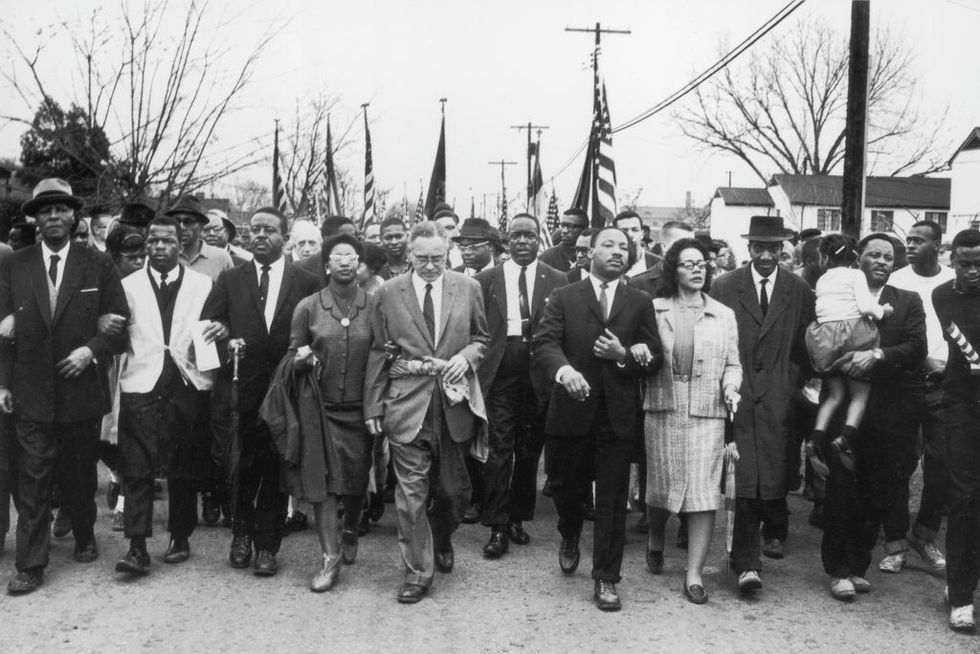
Continuing to focus on voting rights, King, the SCLC, SNCC, and local organizers planned to march peacefully from Selma, Alabama, to the state’s capital, Montgomery.
Led by John Lewis and Hosea Williams , demonstrators set out on March 7, 1965. But the Selma march quickly turned violent as police with nightsticks and tear gas met the demonstrators as they tried to cross the Edmund Pettus Bridge in Selma. The attack was televised, broadcasting the horrifying images of marchers being bloodied and severely injured to a wide audience. Of the 600 demonstrators, 58 were hospitalized in a day that became known as “ Bloody Sunday .” King, however, was spared because he was in Atlanta.
Not to be deterred, activists attempted the Selma-to-Montgomery march again. This time, King made sure he was part of it. Because a federal judge had issued a temporary restraining order on another march, a different approach was taken.
On March 9, 1965, a procession of 2,500 marchers, both Black and white, set out once again to cross the Pettus Bridge and confronted barricades and state troopers. Instead of forcing a confrontation, King led his followers to kneel in prayer, then they turned back. This became known as “Turnaround Tuesday.”
Alabama Governor George Wallace continued to try to prevent another march until President Lyndon B. Johnson pledged his support and ordered U.S. Army troops and the Alabama National Guard to protect the protestors.
On March 21, 1965, approximately 2,000 people began a march from Selma to Montgomery. On March 25, the number of marchers, which had grown to an estimated 25,000 gathered in front of the state capitol where King delivered a televised speech. Five months after the historic peaceful protest, President Johnson signed the 1965 Voting Rights Act .
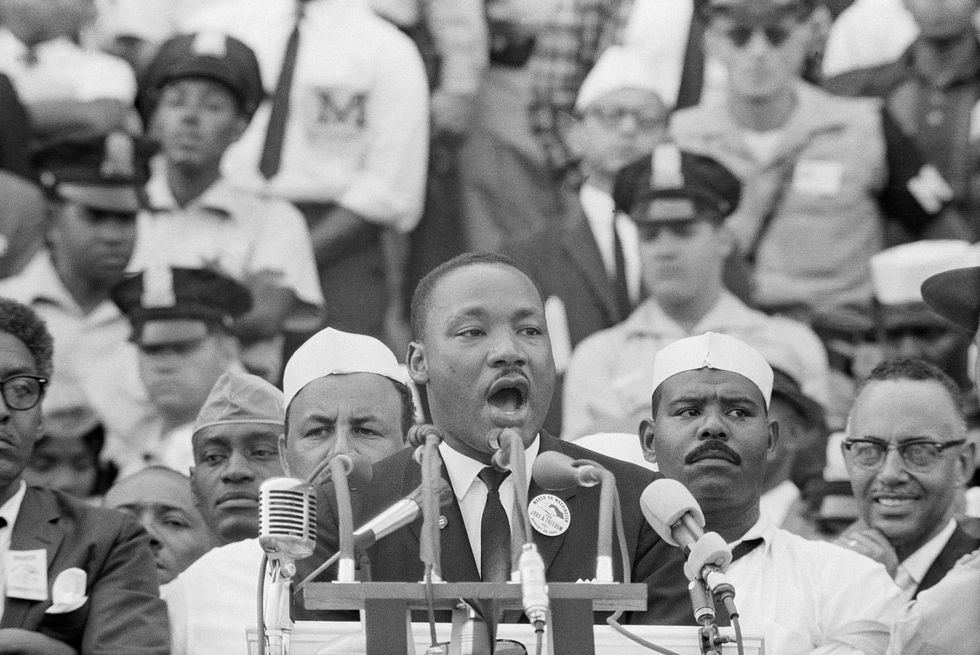
Along with his “I Have a Dream” and “I’ve Been to the Mountaintop” speeches, King delivered several acclaimed addresses over the course of his life in the public eye.
“I Have A Dream” Speech
Date: august 28, 1963.
King gave his famous “I Have a Dream” speech during the 1963 March on Washington. Standing at the Lincoln Memorial, he emphasized his belief that someday all men could be brothers to the 250,000-strong crowd.
Notable Quote: “I have a dream that my four children will one day live in a nation where they will not be judged by the color of their skin but by the content of their character.”
“Give Us the Ballot” Speech
Date: may 17, 1957.
Six years before he told the world of his dream, King stood at the same Lincoln Memorial steps as the final speaker of the Prayer Pilgrimage for Freedom. Dismayed by the ongoing obstacles to registering Black voters, King urged leaders from various backgrounds—Republican and Democrat, Black and white—to work together in the name of justice.
Notable Quote: “Give us the ballot, and we will no longer have to worry the federal government about our basic rights. Give us the ballot, and we will no longer plead to the federal government for passage of an anti-lynching law... Give us the ballot, and we will transform the salient misdeeds of bloodthirsty mobs into the calculated good deeds of orderly citizens.”
Nobel Peace Prize Acceptance Speech
Date: december 10, 1964.
Speaking at the University of Oslo in Norway, King pondered why he was receiving the Nobel Prize when the battle for racial justice was far from over, before acknowledging that it was in recognition of the power of nonviolent resistance. He then compared the foot soldiers of the Civil Rights Movement to the ground crew at an airport who do the unheralded-yet-necessary work to keep planes running on schedule.
Notable Quote: “I think Alfred Nobel would know what I mean when I say that I accept this award in the spirit of a curator of some precious heirloom which he holds in trust for its true owners—all those to whom beauty is truth and truth, beauty—and in whose eyes the beauty of genuine brotherhood and peace is more precious than diamonds or silver or gold.”
“Our God is Marching On (How Long? Not Long)” Speech
Date: march 25, 1965.
At the end of the bitterly fought Selma-to-Montgomery march, King addressed a crowd of 25,000 supporters from the Alabama State Capitol. Offering a brief history lesson on the roots of segregation, King emphasized that there would be no stopping the effort to secure full voting rights, while suggesting a more expansive agenda to come with a call to march on poverty.
Notable Quote: “I come to say to you this afternoon, however difficult the moment, however frustrating the hour, it will not be long, because ‘truth crushed to earth will rise again.’ How long? Not long, because ‘no lie can live forever.’... How long? Not long, because the arc of the moral universe is long, but it bends toward justice.”
“Beyond Vietnam: A Time to Break Silence” Speech
Date: april 4, 1967.
One year before his assassination, King delivered a controversial sermon at New York City’s Riverside Church in which he condemned the Vietnam War. Explaining why his conscience had forced him to speak up, King expressed concern for the poor American soldiers pressed into conflict thousands of miles from home, while pointedly faulting the U.S. government’s role in escalating the war.
Notable Quote: “We still have a choice today: nonviolent coexistence or violent co-annihilation. We must move past indecision to action. We must find new ways to speak for peace in Vietnam and justice throughout the developing world, a world that borders on our doors. If we do not act, we shall surely be dragged down the long, dark, and shameful corridors of time reserved for those who possess power without compassion, might without morality, and strength without sight.”
“I’ve Been to the Mountaintop” Speech
Date: april 3, 1968.
The well-known orator delivered his final speech the day before he died at the Mason Temple in Memphis, Tennessee. King reflected on major moments of progress in history and his own life, in addition to encouraging the city’s striking sanitation workers.
Notable Quote: “I’ve seen the promised land. I may not get there with you. But I want you to know tonight that we, as a people, will get to the promised land.”
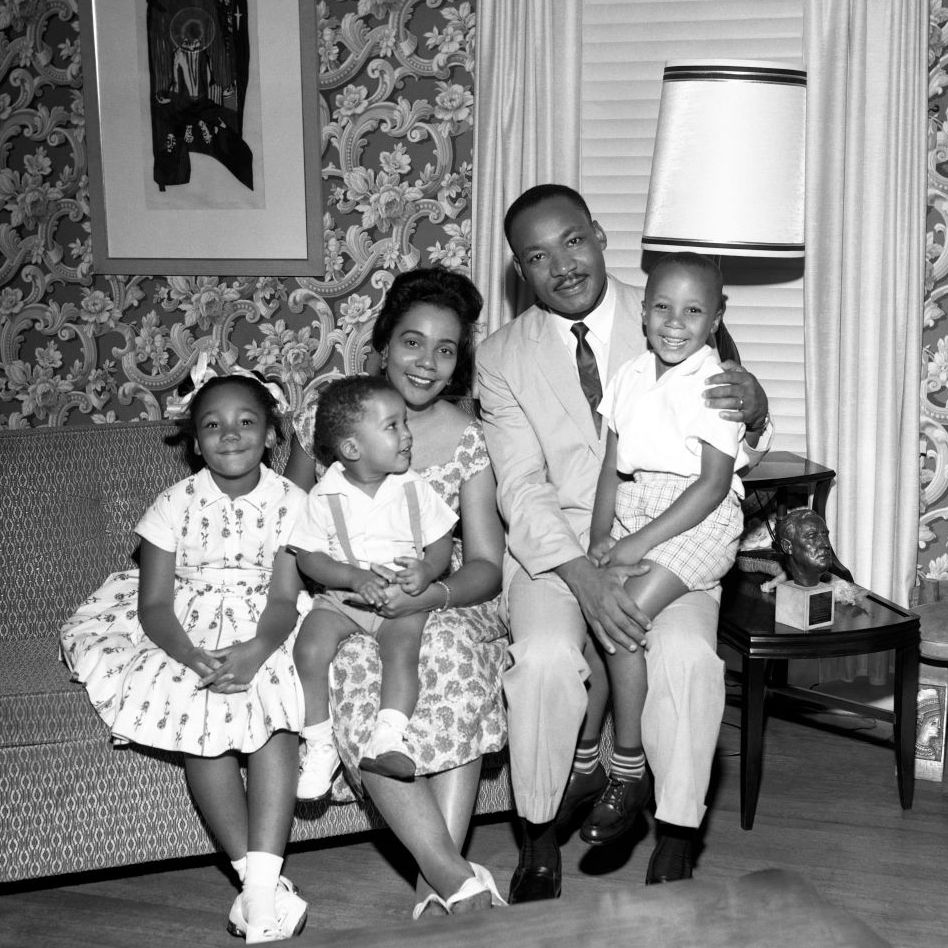
While working on his doctorate at Boston University, King met Coretta Scott , an aspiring singer and musician at the New England Conservatory school in Boston. They were married on June 18, 1953, and had four children—two daughters and two sons—over the next decade. Their oldest, Yolanda, was born in 1955, followed by sons Martin Luther King III in 1957 and Dexter in 1961. The couple welcomed Bernice King in 1963.
Although she accepted the responsibility to raise the children while King travelled the country, Coretta opened their home to organizational meetings and served as an advisor and sounding board for her husband. “I am convinced that if I had not had a wife with the fortitude, strength, and calmness of Corrie, I could not have withstood the ordeals and tensions surrounding the movement,” King wrote in his autobiography.
His lengthy absences became a way of life for their children, but Martin III remembered his father returning from the road to join the kids playing in the yard or bring them to the local YMCA for swimming. King also fostered discussions at mealtimes to make sure everyone understood the important issues he was seeking to resolve.
Leery of accumulating wealth as a high-profile figure, King insisted his family live off his salary as a pastor. However, he was known to splurge on good suits and fine dining, while contrasting his serious public image with a lively sense of humor among friends and family.
Due to his relationships with alleged Communists, King became a target of FBI surveillance and, from late 1963 until his death, a campaign to discredit the civil rights activist. While FBI wiretaps failed to produce evidence of Communist sympathies, they captured the civil rights leader’s engagement in extramarital dalliances. This led to the infamous “suicide letter” of 1964, later confirmed to be from the FBI and authorized by then-Director J. Edgar Hoover , which urged King to kill himself if he wanted to prevent news of his affairs from going public.
In 2019, historian David Garrow wrote of explosive new allegations against King following his review of recently released FBI documents. Among the discoveries was a memo suggesting that King had encouraged the rape of a parishioner in a hotel room, as well as evidence that he might have fathered a daughter with a mistress. Other historians questioned the veracity of the documentation, especially given the FBI’s known attempts to damage King’s reputation. The original surveillance tapes regarding these allegations are under judicial seal until 2027.
From late 1965 through 1967, King expanded his civil rights efforts into other larger American cities, including Chicago and Los Angeles. But he met with increasing criticism and public challenges from young Black power leaders. King’s patient, non-violent approach and appeal to white middle-class citizens alienated many Black militants who considered his methods too weak, too late, and ineffective.
To address this criticism, King began making a link between discrimination and poverty, and he began to speak out against the Vietnam War . He felt America’s involvement in Vietnam was politically untenable and the government’s conduct in the war was discriminatory to the poor. He sought to broaden his base by forming a multiracial coalition to address the economic and unemployment problems of all disadvantaged people. To that end, plans were in the works for another march on Washington to highlight the Poor People’s Campaign, a movement intended to pressure the government into improving living and working conditions for the economically disadvantaged.
By 1968, the years of demonstrations and confrontations were beginning to wear on King. He had grown tired of marches, going to jail, and living under the constant threat of death. He was becoming discouraged at the slow progress of civil rights in America and the increasing criticism from other African American leaders.
In the spring of 1968, a labor strike by Memphis, Tennessee, sanitation workers drew King to one last crusade. On April 3, 1968, he gave his final and what proved to be an eerily prophetic speech, “I’ve Been to the Mountaintop,” in which he told supporters, “Like anybody, I would like to live a long life. Longevity has its place. But I’m not concerned about that now… I’m not worried about anything. I’m not fearing any man. Mine eyes have seen the glory of the coming of the Lord.”
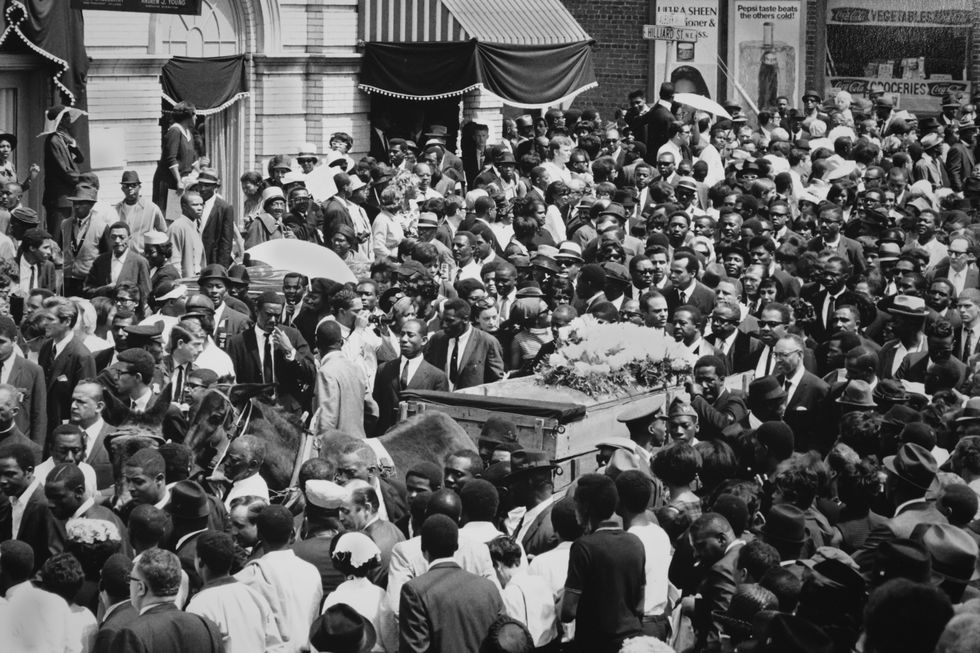
While standing on a balcony outside his room at the Lorraine Motel in Memphis, Tennessee, Martin Luther King Jr. was killed by a sniper’s bullet on April 4, 1968. King died at age 39. The shocking assassination sparked riots and demonstrations in more than 100 cities across the country.
The shooter was James Earl Ray , a malcontent drifter and former convict. He initially escaped authorities but was apprehended after a two-month international manhunt. In 1969, Ray pleaded guilty to assassinating King and was sentenced to 99 years in prison.
The identity of King’s assassin has been the source of some controversy. Ray recanted his confession shortly after he was sentenced, and King’s son Dexter publicly defended Ray’s innocence after meeting with the convicted gunman in 1997. Another complicating factor is the 1993 confession of tavern owner Loyd Jowers, who said he contracted a different hit man to kill King. In June 2000, the U.S. Justice Department released a report that dismissed the alternative theories of King’s death. Ray died in prison on April 23, 1998.
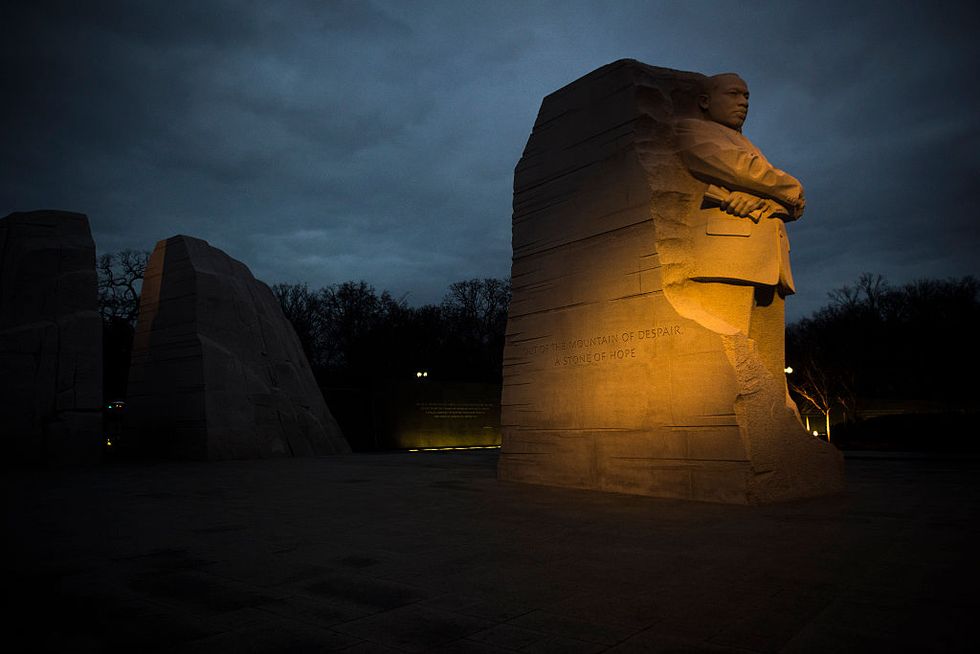
King’s life had a seismic impact on race relations in the United States. Years after his death, he is the most widely known Black leader of his era.
His life and work have been honored with a national holiday, schools and public buildings named after him, and a memorial on Independence Mall in Washington, D.C.
Over the years, extensive archival studies have led to a more balanced and comprehensive assessment of his life, portraying him as a complex figure: flawed, fallible, and limited in his control over the mass movements with which he was associated, yet a visionary leader who was deeply committed to achieving social justice through nonviolent means.
- But we come here tonight to be saved from that patience that makes us patient with anything less than freedom and justice.
- There comes a time when the cup of endurance runs over and men are no longer willing to be plunged into an abyss of injustice where they experience the bleakness of corroding despair.
- Any law that uplifts human personality is just. Any law that degrades human personality is unjust.
- The whirlwinds of revolt will continue to shake the foundations of our nation until the bright day of justice emerges.
- Let us not seek to satisfy our thirst for freedom by drinking from the cup of bitterness and hatred.
- Darkness cannot drive out darkness: only light can do that. Hate cannot drive out hate: only love can do that.
- The ultimate measure of a man is not where he stands in moments of comfort and convenience, but where he stands at times of challenge and controversy. The true neighbor will risk his position, his prestige, and even his life for the welfare of others.
- We must all learn to live together as brothers, or we will all perish together as fools.
- Forgiveness is not an occasional act; it is a permanent attitude.
- I have a dream that my four children will one day live in a nation where they will not be judged by the color of their skin but by the content of their character.
- The function of education, therefore, is to teach one to think intensively and to think critically. But education which stops with efficiency may prove the greatest menace to society. The most dangerous criminal may be the man gifted with reason but with no morals.
- I’ve seen the promised land. I may not get there with you. But I want you to know tonight that we, as a people, will get to the promised land.
- Power at its best is love implementing the demands of justice. Justice at its best is love correcting everything that stands against love.
- A man who won’t die for something is not fit to live.
- At the center of non-violence stands the principle of love.
- Right, temporarily defeated, is stronger than evil triumphant.
- In the end, we will remember not the words of our enemies, but the silence of our friends.
- Injustice anywhere is a threat to justice everywhere.
- Our lives begin to end the day we become silent about things that matter.
Fact Check: We strive for accuracy and fairness. If you see something that doesn’t look right, contact us !
The Biography.com staff is a team of people-obsessed and news-hungry editors with decades of collective experience. We have worked as daily newspaper reporters, major national magazine editors, and as editors-in-chief of regional media publications. Among our ranks are book authors and award-winning journalists. Our staff also works with freelance writers, researchers, and other contributors to produce the smart, compelling profiles and articles you see on our site. To meet the team, visit our About Us page: https://www.biography.com/about/a43602329/about-us
Civil Rights Activists

Martin Luther King Jr. Didn’t Criticize Malcolm X

5 Crowning Achievements of Maya Angelou
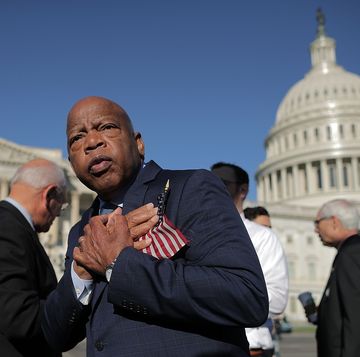
30 Civil Rights Leaders of the Past and Present

Benjamin Banneker
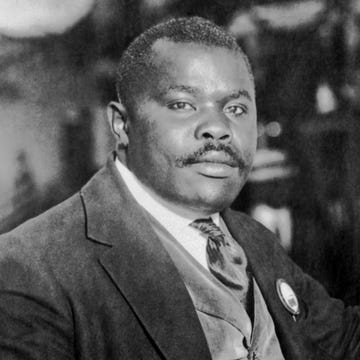
Marcus Garvey

Madam C.J. Walker

Maya Angelou
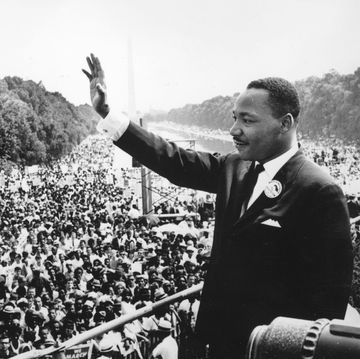
17 Inspiring Martin Luther King Quotes

Bayard Rustin


About Dr. Martin Luther King, Jr.
Dr. king jr..

Drawing inspiration from both his Christian faith and the peaceful teachings of Mahatma Gandhi, Dr. King led a nonviolent movement in the late 1950s and ‘ 60s to achieve legal equality for African-Americans in the United States. While others were advocating for freedom by “any means necessary,” including violence, Martin Luther King, Jr. used the power of words and acts of nonviolent resistance, such as protests, grassroots organizing, and civil disobedience to achieve seemingly-impossible goals. He went on to lead similar campaigns against poverty and international conflict, always maintaining fidelity to his principles that men and women everywhere, regardless of color or creed, are equal members of the human family.
Dr. King’s “I Have a Dream” speech, Nobel Peace Prize lecture and “Letter from a Birmingham Jail” are among the most revered orations and writings in the English language. His accomplishments are now taught to American children of all races, and his teachings are studied by scholars and students worldwide. He is the only non-president to have a national holiday dedicated in his honor and is the only non-president memorialized on the Great Mall in the nation’s capital. He is memorialized in hundreds of statues, parks, streets, squares, churches and other public facilities around the world as a leader whose teachings are increasingly-relevant to the progress of humankind.
Some of Dr. King’s Most Important Achievements

In 1957 , Dr. King was elected president of the Southern Christian Leadership Conference (SCLC), an organization designed to provide new leadership for the now burgeoning civil rights movement. He would serve as head of the SCLC until his assassination in 1968, a period during which he would emerge as the most important social leader of the modern American civil rights movement.
In 1963 , he led a coalition of numerous civil rights groups in a nonviolent campaign aimed at Birmingham, Alabama, which at the time was described as the “most segregated city in America.” The subsequent brutality of the city’s police, illustrated most vividly by television images of young blacks being assaulted by dogs and water hoses, led to a national outrage resulting in a push for unprecedented civil rights legislation. It was during this campaign that Dr. King drafted the “Letter from a Birmingham Jail,” the manifesto of Dr. King’s philosophy and tactics, which is today required-reading in universities worldwide.
Later in 1963 , Dr. King was one of the driving forces behind the March for Jobs and Freedom, more commonly known as the “March on Washington,” which drew over a quarter-million people to the national mall. It was at this march that Dr. King delivered his famous “I Have a Dream” speech, which cemented his status as a social change leader and helped inspire the nation to act on civil rights. Dr. King was later named Time magazine’s “Man of the Year.”

Also in 1964 , partly due to the March on Washington, Congress passed the landmark Civil Rights Act, essentially eliminating legalized racial segregation in the United States. The legislation made it illegal to discriminate against blacks or other minorities in hiring, public accommodations, education or transportation, areas which at the time were still very segregated in many places.
The next year, 1965 , Congress went on to pass the Voting Rights Act, which was an equally-important set of laws that eliminated the remaining barriers to voting for African-Americans, who in some locales had been almost completely disenfranchised. This legislation resulted directly from the Selma to Montgomery, AL March for Voting Rights lead by Dr. King.
Between 1965 and 1968, Dr. King shifted his focus toward economic justice – which he highlighted by leading several campaigns in Chicago, Illinois – and international peace – which he championed by speaking out strongly against the Vietnam War. His work in these years culminated in the “Poor Peoples Campaign,” which was a broad effort to assemble a multiracial coalition of impoverished Americans who would advocate for economic change.
Dr. Martin Luther King, Jr.’s less than thirteen years of nonviolent leadership ended abruptly and tragically on April 4th, 1968 , when he was assassinated at the Lorraine Motel in Memphis, Tennessee. Dr. King’s body was returned to his hometown of Atlanta, Georgia, where his funeral ceremony was attended by high-level leaders of all races and political stripes.
- For more information regarding the Transcription of the King Family Press Conference on the MLK Assassination Trial Verdict December 9, 1999, Atlanta, GA. Click Here
- For more information regarding the Civil Case: King family versus Jowers. Click here .
- Later in 1968, Dr. King’s wife, Mrs. Coretta Scott King, officially founded the Martin Luther King, Jr. Center for Nonviolent Social Change, which she dedicated to being a “living memorial” aimed at continuing Dr. King’s work on important social ills around the world.
We envision the Beloved Community where injustice ceases and love prevails.
Contact Info
449 Auburn Avenue, NE Atlanta, Georgia 30312
404.526.8900
Quick Links
- History Timeline
- King Holiday
- Privacy Policy
- Terms & Conditions
Latest News
- Spotlight on Women’s History Month with The King Center
- The King Center Joins the King Family in Mourning the Loss of Naomi Barber King, wife of Dr. Martin Luther King, Jr’s Late Brother
Stay Connected

- HISTORY & CULTURE
- RACE IN AMERICA
How Martin Luther King, Jr.’s multifaceted view on human rights still inspires today
The legendary civil rights activist pushed to ban nuclear weapons, end the Vietnam War, and lift people out of poverty through labor unions and access to healthcare.
The Reverend Martin Luther King, Jr. towers over history as a civil rights legend—known for leading the movement to end segregation and counter prejudice against Black Americans in the 1950s and 1960s, largely through peaceful protests. He helped pass landmark federal civil rights and voting rights legislation that outlawed segregation and enfranchised Americans who had been barred from the polls through intimidation and discriminatory state and local laws.
( How the Voting Rights Act was won—and why it’s under fire today .)
But King knew it would take more to achieve true equality. And so he also worked tirelessly for education, wage equity, peace, housing, and to lift people out of poverty. Some of King’s most iconic speeches and marches were devoted to ending war, dismantling nuclear weapons, and bringing economic justice. As King said after receiving the Nobel Peace Prize in 1964 , he believed that any “spiritual and moral lag” in humanity was due to racial injustice, poverty, and war.
His multifaceted view on human rights still inspires today, and on the third Monday in January every year, the United States honors King’s legacy of fighting for equal rights—and standing up for human rights everywhere.
During his lifetime, King’s views often made him unpopular and heralded harsh criticism. At the time of his assassination in 1968, a Harris poll revealed a low approval rating of only about 25 percent among white Americans and 52 percent among Black Americans. But in the decades after he was killed, more Americans came to recognize the enormity of King’s contributions. Communities across the country began to name streets and landmarks after him, and soon a push began to establish a federal holiday in his birth month of January.
( Subscriber exclusive: Where the streets have MLK’s name .)
For Hungry Minds
In 1983 , over objections from Southern lawmakers, President Ronald Reagan finally signed a bill creating the holiday into law and the first celebrations of Martin Luther King, Jr. Day took place in January 1986—although it would take another decade for states such as Arizona and South Carolina to follow suit.
King’s work continues to influence and inspire activism—particularly in the realm of environmental justice, as studies indicate that climate change disproportionately harms marginalized communities. Here are the many layers of King’s work that the U.S. honors on Martin Luther King, Jr. Day.
He advocated against the use of nuclear weapons
King was adamant that peace was inextricably linked to civil rights. Throughout the 1950s and 1960s, major powers like the United States and the U.S.S.R. were aggressively developing and testing nuclear weapons, and several times crept to the brink of warfare that threatened to annihilate the world.
King made clear the connection between the Black freedom struggle and the need for nuclear disarmament, writes nuclear studies and African American history expert Vincent Intondi in the book African Americans Against the Bomb: Nuclear Weapons, Colonialism, and the Black Freedom Movement . King argued that it would be “rather absurd” to integrate schools and lunch counters but not be concerned with world peace and survival.
King spoke out about nuclear warfare as early as 1957, when he signed onto a full-page advertisement in The New York Times that called for all nations to suspend nuclear tests immediately. When asked about his stance later that same year, King tied the weapons to the whole of war, and argued that they should be banned everywhere.
“It cannot be disputed that a full-scale nuclear war would be utterly catastrophic,” he told Ebony magazine in an interview. “The principal objective of all nations must be the total abolition of war.”
As part of King’s advocacy for peace and nuclear disarmament, he condemned the bombings of Hiroshima and Nagasaki the U.S. government had carried out more than a decade earlier to effectively end World War II. Today, Hiroshima is one of the only cities outside North America to celebrate Martin Luther King Day.

King also used the Cuban Missile Crisis in October 1962—a 13-day stretch in which the U.S. and Soviet Union stood on the brink of nuclear war over the discovery of Soviet missiles in Cuba—as an opportunity to connect nuclear disarmament to racial and economic justice. King called for the U.S. government to instead turn its attention and funds to education, Medicare, and civil rights, Intondi writes. He then voiced his support for a nuclear test ban treaty , which was signed by President John F. Kennedy in 1963.
He was outspoken against the Vietnam War
King often linked nuclear disarmament with the Vietnam War as it escalated in the 1960s.
King was against the war but initially worried that making his stance public would derail his work to pass the Civil Rights Act and impair his relationship with President Lyndon B. Johnson, according to the Martin Luther King, Jr. Research and Education Institute at Stanford University .
But in 1965, the year the first U.S. ground troops were sent to Vietnam, King issued his first public statement, asserting the war was “accomplishing nothing” and calling for a peace treaty.
He tempered his criticism for the next two years to avoid diminishing the impact of his civil rights work, but by 1967, King was active in the anti-war sphere again, attending a march in Chicago before he went on to make his most notable speech on the matter a few days later on April 4.
It is no longer a choice, my friends, between violence and nonviolence. It is either nonviolence or nonexistence. And the alternative to disarmament… may well be a civilization plunged into the abyss of annihilation , and our earthly habitat would be transformed into an inferno that even the mind of Dante could not imagine. Martin Luther King, Jr.
On that day at the Riverside Church in New York City, King denounced the war for deepening the problems of Black Americans and people living in poverty. He condemned the “madness” of Vietnam as a “symptom of a far deeper malady” that put the U.S. at odds with the aspirations for social justice throughout the world. Just 11 days later, King led 125,000 demonstrators on an anti-war march to the United Nations headquarters in New York as one of the largest peace demonstrations in history.
You May Also Like

Harriet Tubman, the spy: uncovering her secret Civil War missions

MLK and Malcolm X only met once. Here’s the story behind an iconic image.

Why Aboriginal Australians are still fighting for recognition
During the last year of his life , King continued his anti-war work by encouraging grassroots peace activism. On March 31, 1968, five days before he died, King denounced the Vietnam War in his final Sunday sermon at the National Cathedral in Washington, D.C., saying that it was “one of the most unjust wars that has ever been fought in the history of the world.”
King did not live to see the war end. U.S. troops officially pulled out of Vietnam in April 1975 .
He championed union representation and worker’s rights
King's passion for union representation and workers' rights is also an important part of his legacy. Much as he had done with his anti-war speeches, King often tied workers’ rights to the civil rights movement.
“I had also learned that the inseparable twin of racial injustice was economic injustice,” King said in a 1958 speech in New York . “Although I came from a home of economic security and relative comfort, I could never get out of my mind the economic insecurity of many of my playmates and the tragic poverty of those living around me.”
In a 1959 interview with Challenge magazine , King acknowledged that labor unions had historically left out Black Americans, but also could be a key to economic justice. He called for Black Americans to organize their economic and political power in the form of labor unions, and he championed ideas in the labor movement, including better working conditions, adequate housing, guaranteed annual income, and access to healthcare.

For years, King continued to call for economic justice, notably at the August 28, 1963, March on Washington for Jobs and Freedom. Before a crowd of 250,000 people, he delivered the legendary “I Have A Dream” speech on the steps of the Lincoln Memorial, where he called for an end to poverty, especially targeted poverty and discrimination against Black Americans.
One of King’s last actions before his assassination was in support of the labor movement. King’s final days were spent supporting a group of Black sanitation workers striking in Memphis, Tennessee.
After two workers had been crushed to death by a malfunctioning truck, 1,300 Black workers went on strike for 11 days, seeking an end to a long pattern of neglect and abuse from their management. The strike would’ve ended after the City Council voted to recognize their newly formed union, but the Memphis mayor rejected the vote. King traveled to Memphis to lead a protest march and, on April 3, he spoke to the striking sanitation workers.
“We’ve got to give ourselves to this struggle until the end,” King said . “Nothing would be more tragic than to stop at this point in Memphis. We’ve got to see it through.”
King was gunned down by an assassin on the balcony of his Memphis hotel the next day. On April 16, the sanitation workers’ union was finally recognized and a better wage was promised—the first of many examples of how King’s legacy would continue to reverberate in the work of those whom he inspired.
I have the audacity to believe that peoples everywhere can have three meals a day for their bodies, education and culture for their minds, and dignity, equality and freedom for their spirits. Martin Luther King, Jr.
He’s inspiring a new generation of environmental activists
Although King’s last act supporting the Black sanitation workers in Memphis was not explicitly an act of environmental justice , it has inspired a generation of activists. The working conditions the sanitation workers had endured were polluted and hazardous—much like the conditions many Black Americans endured in their communities and jobs at the time.
Modern environmental activists have drawn on King’s message: Much as segregation and discrimination were inseparable from poverty, they point out that poor communities of color disproportionately face environmental hazards such as pollution. They also bear the brunt of the harmful effects of climate change, including extreme weather events.
( The origins of environmental justice—and why it’s finally getting the attention it deserves .)
Title VI of the Civil Rights Act of 1964, which prohibits discrimination in the use of federal funds , even gave marginalized people a means to address racial discrimination in environmental matters. As the environmental justice movement grew, King’s work also inspired the Clean Air Act, the Clean Water Act, and the Endangered Species Act.
His advocacy for people of color to have a voice and power has inspired many communities impacted most by climate change to speak up—and take action. Now, the holiday honoring King is typically observed as a national day of service. Organizations and individuals alike volunteer for their communities, often cleaning up roads or river banks in the name of a man who many believe would be on the forefront of the climate fight if he were still alive today.
Related Topics
- CIVIL RIGHTS
- HUMAN RIGHTS
- ENVIRONMENTAL JUSTICE
- NUCLEAR WEAPONS
- VIETNAM WAR

Meet the mom who took on toxic waste—and won

How Emmett Till’s murder catalyzed the U.S. civil rights movement

This is what you need to know about lead and your health

How César Chávez changed the labor movement—and became an icon

What was the Stonewall uprising?
- Paid Content
- Environment
- Photography
- Perpetual Planet
History & Culture
- History & Culture
- History Magazine
- Mind, Body, Wonder
- Terms of Use
- Privacy Policy
- Your US State Privacy Rights
- Children's Online Privacy Policy
- Interest-Based Ads
- About Nielsen Measurement
- Do Not Sell or Share My Personal Information
- Nat Geo Home
- Attend a Live Event
- Book a Trip
- Inspire Your Kids
- Shop Nat Geo
- Visit the D.C. Museum
- Learn About Our Impact
- Support Our Mission
- Advertise With Us
- Customer Service
- Renew Subscription
- Manage Your Subscription
- Work at Nat Geo
- Sign Up for Our Newsletters
- Contribute to Protect the Planet
Copyright © 1996-2015 National Geographic Society Copyright © 2015-2024 National Geographic Partners, LLC. All rights reserved
- This Day In History
- History Classics
- HISTORY Podcasts
HISTORY Vault
- Link HISTORY on facebook
- Link HISTORY on twitter
- Link HISTORY on youtube
- Link HISTORY on instagram
- Link HISTORY on tiktok
✯ ✯ ✯ Dr. Martin Luther King Jr. ✯ ✯ ✯ His Life and Legacy
Martin Luther King Jr. dedicated his life to the nonviolent struggle for civil rights in the United States. King's leadership played a pivotal role in ending entrenched segregation for African Americans and to the creation of the Civil Rights Act of 1964, considered a crowning achievement of the civil rights era. King was assassinated in 1968, but his words and legacy continue to resonate for all those seeking justice in the United States and around the world. As King said at the Washington National Cathedral on March 31, 1968, "Darkness cannot drive out darkness; only light can do that. Hate cannot drive out hate; only love can do that."
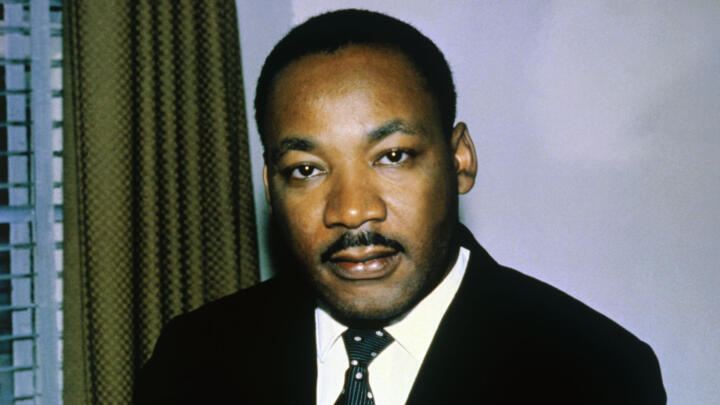
10 Things You May Not Know About Martin Luther King Jr.
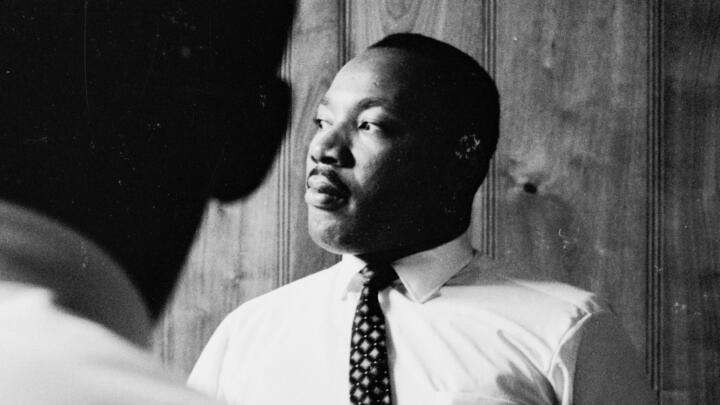
An Intimate View of MLK Through the Lens of a Friend

The Fight for Martin Luther King Jr. Day
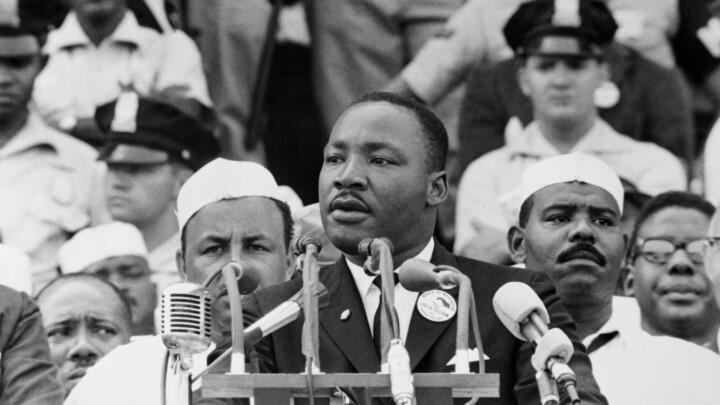
7 of Martin Luther King Jr.'s Most Notable Speeches


Martin Luther King Jr.

7 Things You May Not Know About MLK’s 'I Have a Dream' Speech
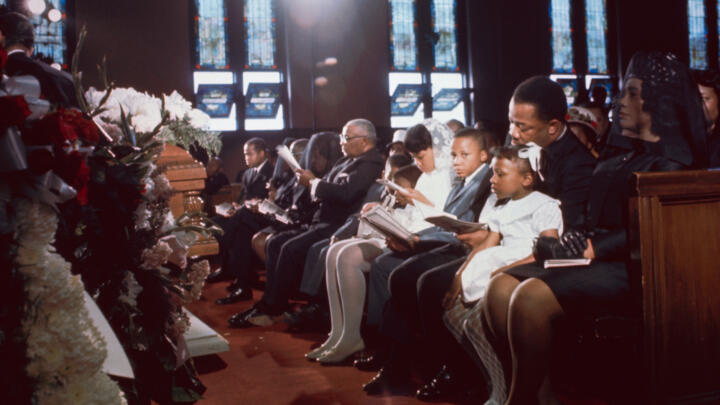
America in Mourning After MLK's Shocking Assassination: Photos

For Martin Luther King Jr., Nonviolent Protest Never Meant ‘Wait and See’
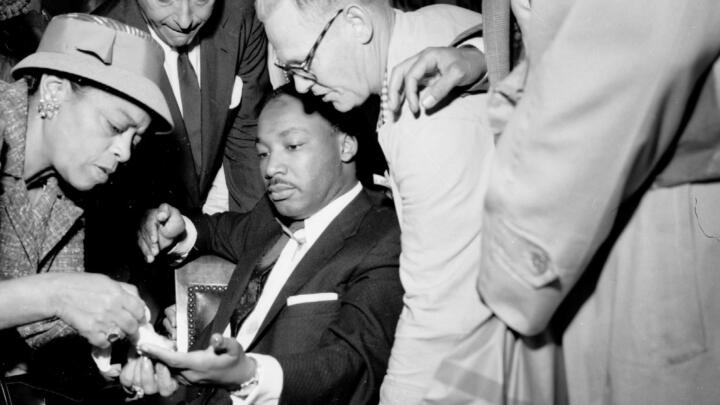
How an Assassination Attempt Affirmed MLK’s Faith in Nonviolence

Jesse Jackson on M.L.K.: One Bullet Couldn’t Kill the Movement
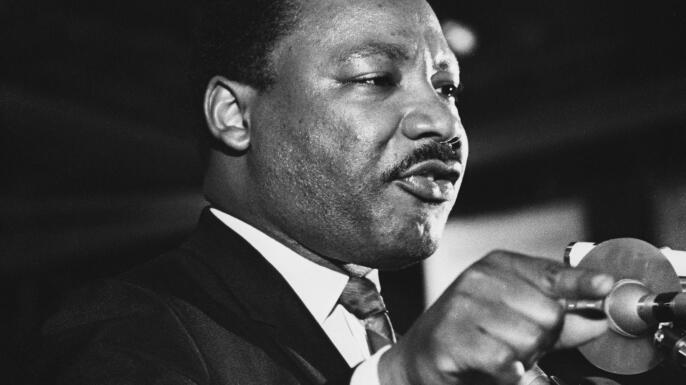
Martin Luther King Jr.’s Final Speech

MLK's Poor People's Campaign Demanded Economic Justice
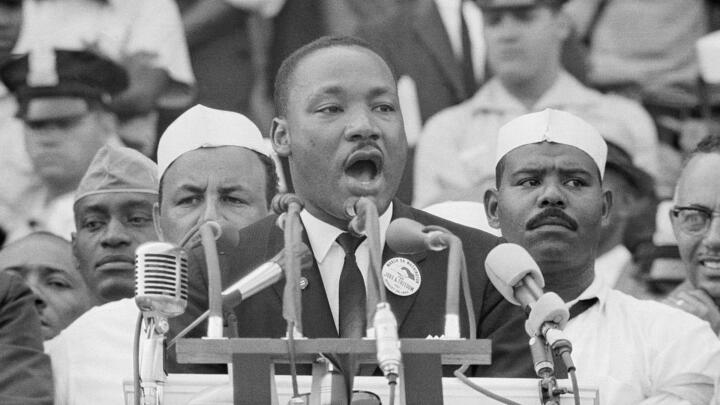
Martin Luther King Jr.’s Famous Speech Almost Didn’t Have the Phrase 'I Have a Dream'

How Selma's 'Bloody Sunday' Became a Turning Point in the Civil Rights Movement
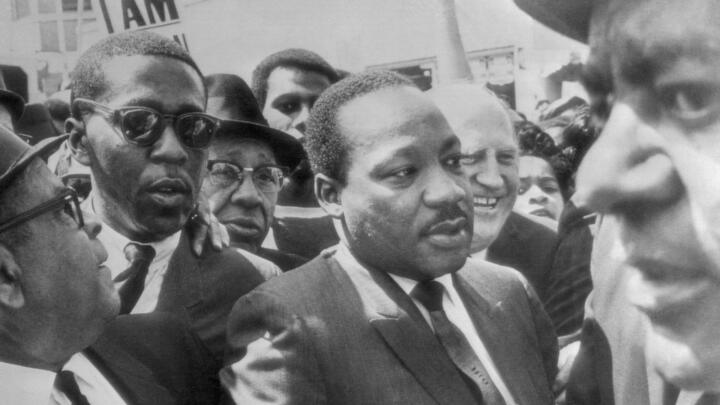
Playlist: Dr. Martin Luther King Jr.
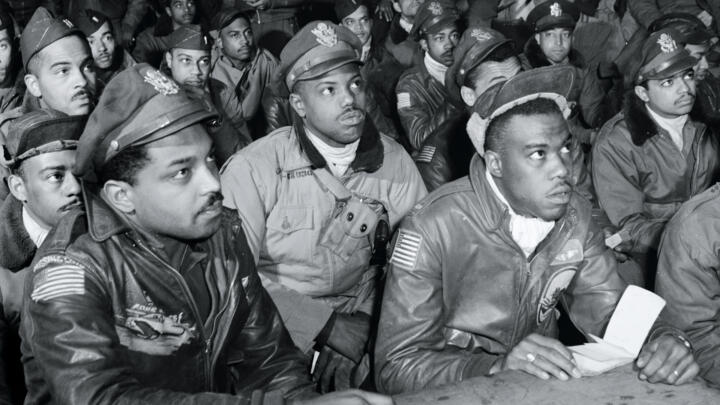
Watch the Black History collection on HISTORY Vault to look back on the history of African American achievements.
Get instant access to free updates.
Don’t Miss Out on HISTORY news, behind the scenes content, and more.
- Privacy Notice
- Terms of Use
Need help with the site?
Create a profile to add this show to your list.
An Experiment in Love: Martin Luther King, Jr. on the Six Pillars of Nonviolent Resistance and the Ancient Greek Notion of ‘Agape’
By maria popova.

Nowhere does he transmute spiritual ideas from various traditions into secular principles more masterfully than in his extraordinary 1958 essay “An Experiment in Love,” in which he examines the six essential principles of his philosophy of nonviolence, debunks popular misconceptions about it, and considers how these basic tenets can be used in guiding any successful movement of nonviolent resistance. Penned five years before his famous Letter from Birmingham City Jail and exactly a decade before his assassination, the essay was eventually included in the indispensable A Testament of Hope: The Essential Writings and Speeches of Martin Luther King, Jr. ( public library ) — required reading for every human being with a clicking mind and a ticking heart.

In the first of the six basic philosophies, Dr. King addresses the tendency to mistake nonviolence for passivity, pointing out that it is a form not of cowardice but of courage:
It must be emphasized that nonviolent resistance is not a method for cowards; it does resist. If one uses this method because he is afraid or merely because he lacks the instruments of violence, he is not truly nonviolent. This is why Gandhi often said that if cowardice is the only alternative to violence, it is better to fight… The way of nonviolent resistance … is ultimately the way of the strong man. It is not a method of stagnant passivity… For while the nonviolent resister is passive in the sense that he is not physically aggressive toward his opponent, his mind and his emotions are always active, constantly seeking to persuade his opponent that he is wrong. The method is passive physically but strongly active spiritually. It is not passive non-resistance to evil, it is active nonviolent resistance to evil.
He turns to the second tenet of nonviolence:
Nonviolence … does not seek to defeat or humiliate the opponent, but to win his friendship and understanding. The nonviolent resister must often express his protest through noncooperation or boycotts, but he realizes that these are not ends themselves; they are merely means to awaken a sense of moral shame in the opponent. The end is redemption and reconciliation. The aftermath of nonviolence is the creation of the beloved community, while the aftermath of violence is tragic bitterness.

In considering the third characteristic of nonviolence, Dr. King appeals to the conscientious recognition that those who perpetrate violence are often victims themselves:
The attack is directed against forces of evil rather than against persons who happen to be doing the evil. It is the evil that the nonviolent resister seeks to defeat, not the persons victimized by the evil. If he is opposing racial injustice, the nonviolent resister has the vision to see that the basic tension is not between the races… The tension is, at bottom, between justice and injustice, between the forces of light and the forces of darkness…. We are out to defeat injustice and not white persons who may be unjust.
Out of this recognition flows the fourth tenet:
Nonviolent resistance [requires] a willingness to accept suffering without retaliation, to accept blows from the opponent without striking back… The nonviolent resister is willing to accept violence if necessary, but never to inflict it. He does not seek to dodge jail. If going to jail is necessary, he enters it “as a bridegroom enters the bride’s chamber.”
That, in fact, is precisely how Dr. King himself entered jail five years later . To those skeptical of the value of turning the other cheek, he offers:
Unearned suffering is redemptive. Suffering, the nonviolent resister realizes, has tremendous educational and transforming possibilities.
The fifth basic philosophy turns the fourth inward and arrives at the most central point of the essay — the noblest use of what we call “love”:
Nonviolent resistance … avoids not only external physical violence but also internal violence of spirit. The nonviolent resister not only refuses to shoot his opponent but he also refuses to hate him. At the center of nonviolence stands the principle of love. The nonviolent resister would contend that in the struggle for human dignity, the oppressed people of the world must not succumb to the temptation of becoming bitter or indulging in hate campaigns. To retaliate in kind would do nothing but intensify the existence of hate in the universe. Along the way of life, someone must have sense enough and morality enough to cut off the chain of hate. This can only be done by projecting the ethic of love to the center of our lives.

Here, Dr. King turns to Ancient Greek philosophy, pointing out that the love he speaks of is not the sentimental or affectionate kind — “it would be nonsense to urge men to love their oppressors in an affectionate sense,” he readily acknowledges — but love in the sense of understanding and redemptive goodwill. The Greeks called this agape — a love distinctly different from the eros , reserved for our lovers, or philia , with which we love our friends and family. Dr. King explains:
Agape means understanding, redeeming good will for all men. It is an overflowing love which is purely spontaneous, unmotivated, groundless, and creative. It is not set in motion by any quality or function of its object… Agape is disinterested love. It is a love in which the individual seeks not his own good, but the good of his neighbor. Agape does not begin by discriminating between worthy and unworthy people, or any qualities people possess. It begins by loving others for their sakes . It is an entirely “neighbor-regarding concern for others,” which discovers the neighbor in every man it meets. Therefore, agape makes no distinction between friends and enemy; it is directed toward both. If one loves an individual merely on account of his friendliness, he loves him for the sake of the benefits to be gained from the friendship, rather than for the friend’s own sake. Consequently, the best way to assure oneself that love is disinterested is to have love for the enemy-neighbor from whom you can expect no good in return, but only hostility and persecution.
This notion is nearly identical to one of Buddhism’s four brahmaviharas , or divine attitudes — the concept of Metta , often translated as lovingkindness or benevolence. The parallel speaks not only to Dr. King’s extraordinarily diverse intellectual toolkit of influences and inspirations — a high form of combinatorial creativity necessary for any meaningful contribution to humanity’s common record — but also to the core commonalities between the world’s major spiritual and philosophical traditions.
In a sentiment that Margaret Mead and James Baldwin would echo twelve years later in their spectacular conversation on race — “In any oppressive situation both groups suffer, the oppressors and the oppressed,” Mead observed, asserting that the oppressors suffer morally with the recognition of what they’re committing, which Baldwin noted is “a worse kind of suffering” — Dr. King adds:
Another basic point about agape is that it springs from the need of the other person — his need for belonging to the best in the human family… Since the white man’s personality is greatly distorted by segregation, and his soul is greatly scarred, he needs the love of the Negro. The Negro must love the white man, because the white man needs his love to remove his tensions, insecurities, and fears.

At the heart of agape , he argues, is the notion of forgiveness — something Mead and Baldwin also explored with great intellectual elegance . Dr. King writes:
Agape is not a weak, passive love. It is love in action… Agape is a willingness to go to any length to restore community… It is a willingness to forgive, not seven times, but seventy times seven to restore community…. If I respond to hate with a reciprocal hate I do nothing but intensify the cleavage in broken community. I can only close the gap in broken community by meeting hate with love.
With this, he turns to the sixth and final principle of nonviolence as a force of justice, undergirded by the nonreligious form of spirituality that Dani Shapiro elegantly termed “an animating presence” and Alan Lightman described as the transcendence of “this strange and shimmering world.” Dr. King writes:
Nonviolent resistance … is based on the conviction that the universe is on the side of justice. Consequently, the believer in nonviolence has deep faith in the future. This faith is another reason why the nonviolent resister can accept suffering without retaliation. For he knows that in his struggle for justice he has cosmic companionship. It is true that there are devout believers in nonviolence who find it difficult to believe in a personal God. But even these persons believe in the existence of some creative force that works for universal wholeness. Whether we call it an unconscious process, an impersonal Brahman, or a Personal Being of matchless power of infinite love, there is a creative force in this universe that works to bring the disconnected aspects of reality into a harmonious whole.
A Testament of Hope is an absolutely essential read in its totality. Complement it with Dr. King on the two types of law , Albert Einstein’s little-known correspondence with W.E.B. Du Bois on racial justice , and Tolstoy and Gandhi’s equally forgotten but immensely timely correspondence on why we hurt each other .
— Published July 1, 2015 — https://www.themarginalian.org/2015/07/01/martin-luther-king-jr-an-experiment-in-love/ —

www.themarginalian.org

PRINT ARTICLE
Email article, filed under, activism culture history love martin luther king philosophy politics psychology, view full site.
The Marginalian participates in the Bookshop.org and Amazon.com affiliate programs, designed to provide a means for sites to earn commissions by linking to books. In more human terms, this means that whenever you buy a book from a link here, I receive a small percentage of its price, which goes straight back into my own colossal biblioexpenses. Privacy policy . (TLDR: You're safe — there are no nefarious "third parties" lurking on my watch or shedding crumbs of the "cookies" the rest of the internet uses.)
Along with Stanford news and stories, show me:
- Student information
- Faculty/Staff information
We want to provide announcements, events, leadership messages and resources that are relevant to you. Your selection is stored in a browser cookie which you can remove at any time using “Clear all personalization” below.
As our nation remembers the lasting legacy of the Reverend Dr. Martin Luther King, Jr. this month, we are gripped by political and civil unrest and deep societal divisions. Across the nation, Black Lives Matter protests erupted again this past summer in response to the killing of George Floyd and others in the Black community, prompting urgent calls for confronting and ending racism and for a renewed effort to correct historic racial injustices and inequities.
Go to the web site to view the video.
On April 14, 1967, Martin Luther King, Jr., visited Stanford University and gave a talk entitled “The Other America” at Memorial Auditorium. This is a short excerpt from his speech.
In his 1963 Letter from the Birmingham Jail, Dr. King wrote: “Let us all hope that the dark clouds of racial prejudice will soon pass away and the deep fog of misunderstanding will be lifted from our fear-drenched communities, and in some not too distant tomorrow the radiant stars of love and brotherhood will shine over our great nation with all their scintillating beauty.”
Dr. King’s legacy lives on not only through his writing, speeches and efforts to create a just and more equitable society for all, but also through those he inspired. Stanford Report asked several scholars in the School of Humanities and Sciences to share the impact Dr. King has had on them and their work.
James T. Campbell
James Campbell (Image credit: Leah Campbell)
Edgar E. Robinson Professor in United States History
I am just old enough to remember Dr. King, but my appreciation of him developed in graduate school, thanks to one of my Stanford teachers, Clayborne Carson . Clay introduced me to a more complex, challenging figure than the one comfortably ensconced in the nation’s collective memory.
Everyone today quotes the “I have a dream” speech, but what do we know of the King who risked his political career to condemn the war in Vietnam, who declared that every bomb dropped overseas exploded in an American city, who asked what good it was to sit at a lunch counter if one couldn’t afford a hamburger, who marched in Chicago for fair housing and came to Memphis, where he died, to support striking garbagemen?
If we truly wish to honor King, if we truly hope to find in his life some insight into our own historical predicament, we need first to see him whole.
Jackelyn Hwang
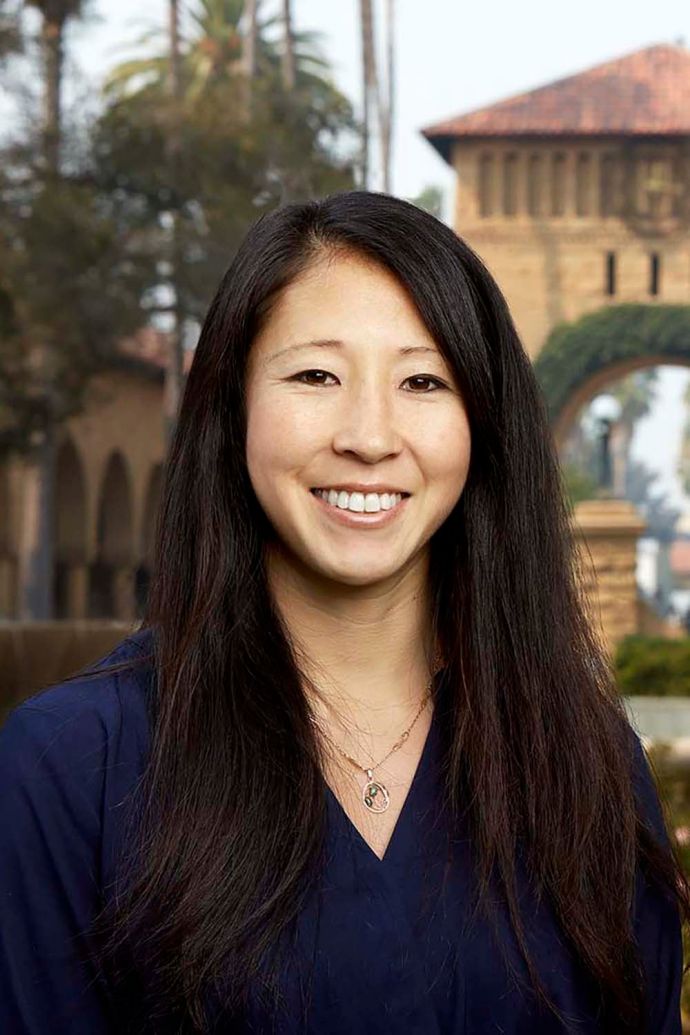
Jackelyn Hwang (Image credit: Steve Gladfelter)
Assistant Professor, Sociology
Dr. King dreamed of true equality. He dreamed not only of an end to legal segregation but of a just world in which our social, economic and political institutions allowed all individuals access to resources and opportunities that enabled true citizenship and potential. The injustices that Dr. King fought so hard against motivated me to become a scholar of housing inequality and residential segregation.
My research and the continued occurrence of distressing events, like the storming of the Capitol and the murders of George Floyd and Breonna Taylor, serve as constant reminders that we have a long way to go to achieve Dr. King’s vision. Yet, in a time of different circumstances, Dr. King believed that we could achieve it.
Dr. King’s conviction and courage have and will always inspire me to share his vision and continue my efforts to dismantle the racist institutions that perpetuate neighborhood inequality and segregation.
Ato Quayson

Ato Quayson (Image credit: Paul Keitz)
Jean G. And Morris M. Doyle Professor in Interdisciplinary Studies, English
Martin Luther King, Jr., has been a beacon of reason and hope to me and my friends since I was a teenager. His quip about planting an apple tree today if he was told that the world was going to end tomorrow has had a special resonance for me since then.
We didn’t have apple trees in Ghana where I grew up, but the principle of tending something fragile into a bounty of fruitfulness against all odds was one that I have never forgotten. And I have apple trees of my own now.
Wendy Salkin
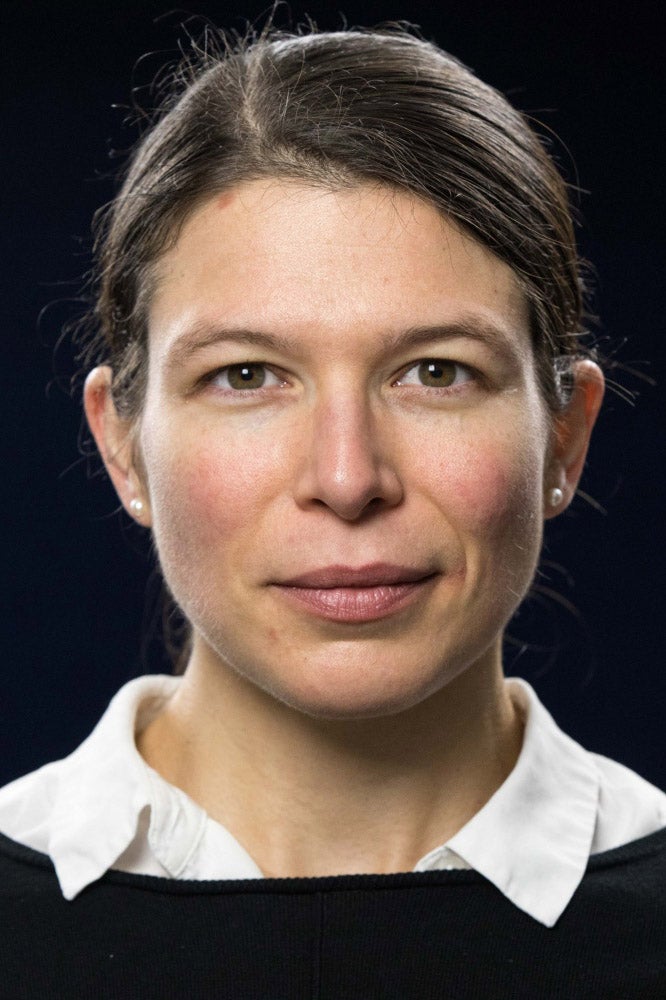
Wendy Salkin (Image credit: Courtesy Wendy Salkin)
Assistant Professor, Philosophy
I have often thought that one way to assess whether a thinker has influenced one’s work is by answering this question: Is their book on your desk right now? If an affirmative answer indicates their depth of influence (as I think it does), then it is worth mentioning that Dr. King’s Stride Toward Freedom: The Montgomery Story never leaves my desk.
My scholarship on informal political representation has been profoundly shaped by King’s reflections on being a spokesperson for Black residents of Montgomery, Alabama, during the bus boycott. King writes: “I neither started the protest nor suggested it. I simply responded to the call of the people for a spokesman.” Inspired by King’s reflections, in my research I consider what it means to be called by others to serve as an informal political representative. When must one heed this call and when may one reject it?
King’s historically informed approach to political philosophy has deeply influenced my sense of what political philosophy is for and what are its stakes. Philosophers are sometimes criticized for advancing ahistorical arguments concerning, say, what justice requires. King shows us the importance of situating our theoretical reflections on justice within historical contexts, saying not just what justice requires but also laying bare what its absence looks like in real life.
Matthew Snipp
Matthew Snipp (Image credit: L.A. Cicero)
Burnet C. and Mildred Finley Wohlford Professor in the School of Humanities and Sciences, SociologyVice Provost for Faculty Development, Diversity and Engagement
I’ve spent my entire career teaching and writing about race relations in America. I have an unbounded respect and admiration for Dr. King’s accomplishments. His pursuit of social justice for oppressed people everywhere was relentless, and he made America better.
But the sight of Confederate flags in the Capitol on Wednesday, Jan. 6, only underscores how much more work must be done before we become the kind of nation that Dr. King imagined. We live in the shadow of slavery, the expropriation of Native land, and racial inequality is encoded into the DNA of our nation. This wasn’t undone by the 14th and 15th amendments, and it wasn’t undone by the Civil Rights Acts of 1866 and 1964, or the panoply of civil rights protections passed into law in the 1960s.
Still, undo it we must for the future of our nation, for coming generations of Americans and to realize Dr. King’s vision.
Media Contacts
Joy Leighton, Stanford School of Humanities and Sciences: [email protected]
National Historical Publications & Records Commission

The Papers of Martin Luther King, Jr.
Stanford University
Additional information: https://kinginstitute.stanford.edu/publications/king-papers
A comprehensive edition of the papers of Martin Luther King, Jr. (1929 –1968) clergyman, activist, and leader in the African-American Civil Rights Movement. He is best known for his role in the advancement of civil rights using nonviolent civil disobedience. King has become a national icon in the history of American progressivism. A Baptist minister, King became a civil rights activist early in his career. He led the 1955 Montgomery Bus Boycott and helped found the Southern Christian Leadership Conference (SCLC) in 1957, serving as its first president. With the SCLC, King led an unsuccessful struggle against segregation in Albany, Georgia, in 1962, and organized nonviolent protests in Birmingham, Alabama, that attracted national attention following television news coverage of the brutal police response. King also helped to organize the 1963 March on Washington, where he delivered his "I Have a Dream" speech. This edition of speeches, sermons, correspondence, and other papers of America’s foremost leader of the civil rights movement of the 1950s and 1960s. The project was initiated by the King Center in Atlanta before moving to the Martin Luther King, Jr. Research and Education Institute at Stanford.
Seven completed volumes of a planned 14-volume edition
Martin Luther King, Jr. addresses the crowd at the Civil Rights March, August 28, 1963. National Archives.
Previous Record | Next Record | Return to Index
Home — Essay Samples — Social Issues — Racism — Martin Luther King
Essays on Martin Luther King
Hook examples for martin luther king essays, the dream that changed america hook.
Begin your essay by quoting Martin Luther King Jr.'s iconic "I Have a Dream" speech. Explore the impact of this speech on civil rights and its enduring significance in the fight for equality.
The Montgomery Bus Boycott Hook
Introduce the Montgomery Bus Boycott as a pivotal moment in Dr. King's activism. Describe the events leading to the boycott and its role in shaping the civil rights movement.
The Letter from Birmingham Jail Hook
Discuss the powerful "Letter from Birmingham Jail" written by Dr. King during his imprisonment. Examine the letter's arguments for civil disobedience and its impact on the struggle for justice.
The March on Washington Hook
Highlight the significance of the March on Washington for Jobs and Freedom in 1963. Describe the event, its participants, and Dr. King's historic "I Have a Dream" speech delivered at the Lincoln Memorial.
The Nonviolent Resistance Hook
Explore Martin Luther King Jr.'s philosophy of nonviolent resistance and its influence on the civil rights movement. Discuss the strategies and principles behind nonviolent protest.
The Legacy of Dr. King Hook
Reflect on Dr. King's lasting legacy and his impact on civil rights, social justice, and the quest for equality. Discuss how his work continues to inspire change today.
The Assassination and Mourning Hook
Examine the tragic assassination of Martin Luther King Jr. in 1968 and the national mourning that followed. Discuss the immediate aftermath and the long-term effects on the civil rights movement.
The Global Influence Hook
Discuss how Martin Luther King Jr.'s message of equality and justice resonated beyond the United States, inspiring movements for civil rights and social change around the world.
The Continuing Struggle Hook
Connect Dr. King's work to ongoing struggles for racial and social justice. Explore how contemporary movements draw inspiration from his teachings and activism.
The Man Behind the Legend Hook
Offer a glimpse into Martin Luther King Jr.'s personal life, upbringing, and motivations. Explore the man behind the iconic figure and shed light on his character and values.
Rhetorical Analysis of Martin Luther King's Historic Speech
Allusion in i have a dream speech, made-to-order essay as fast as you need it.
Each essay is customized to cater to your unique preferences
+ experts online
Civil Disobedience Rhetorical Analysis
Martin luther king jr: impact on society, martin luther king jr: influential figure in the civil rights movement, different examples of "freedom is never given it must be demanded" in books, let us write you an essay from scratch.
- 450+ experts on 30 subjects ready to help
- Custom essay delivered in as few as 3 hours
Analysis of Martin Luther King's "I Have a Dream" Speech
Martin luther king's purpose in his speech beyond vietnam: a time to break silence, the life and legacy of martin luther king jr., the impact of martin luther king on american civil rights, get a personalized essay in under 3 hours.
Expert-written essays crafted with your exact needs in mind
The Use of Rhetorical Devices in I Have a Dream Speech by Dr. Martin Luther King Jr.
Impact of martin luther king jr's speech, work to spark the reformation: martin luther king's opposition to the church authority, martin luther king, malcolm x, and rosa parks in the fight against racial inequality, struggle of martin luther king jr. and aneeka pasha, martin luther king jr.: leadership characteristics and legacy, how martin luther king jr's influence shaped american people, the effects of the speech by martin luther king after his death, a personal analysis of i have a dream, a speech by martin luther king jr, the role of martin luther king jr. and malcolm x in civil rights movement, letter from birmingham jail: the rhetorical analysis, analysis of martin luther king jr. as a great leader, 20th-century freedom movements, racism in i have a dream, martin luther king jr.: was everything in vain, analysis of pathos, ethos, and logos in the letter from birmingham jail, martin luther king jr.: life and legacy of a civil rights icon, "i have a dream" by martin luther king, comparison of king’s letter from birmingham jail and lincoln's inaugural address, rhetorical devices, pathos, ethos and logos in 'i have a dream' speech.
January 10, 1957 – April 4, 1968
Martin Luther King Jr. was a prominent leader in the American civil rights movement during the mid-20th century. He dedicated his life to advocating for racial equality and social justice through nonviolent means. King played a crucial role in the advancement of civil rights for African Americans, challenging segregation and discrimination prevalent in American society. King's activism extended beyond racial issues. He spoke out against the Vietnam War, advocating for peace and justice on a global scale. His commitment to nonviolent resistance and civil disobedience inspired millions and earned him international recognition, including the Nobel Peace Prize in 1964.
The American Civil Rights Movement, the Memphis Sanitation Workers’ Strike, the Montgomery Bus Boycott, and the March on Washington
One of King's most notable contributions was his leadership in the Montgomery Bus Boycott in 1955, sparked by Rosa Parks' refusal to give up her bus seat to a white person. The boycott led to a landmark Supreme Court ruling against racial segregation in public transportation. King also organized and participated in numerous peaceful protests, including the famous March on Washington in 1963, where he delivered his iconic "I Have a Dream" speech, calling for racial harmony and equality. King's leadership played a pivotal role in the passage of important legislation, including the Civil Rights Act of 1964 and the Voting Rights Act of 1965, which aimed to dismantle segregation and protect the voting rights of African Americans. His peaceful protests and demonstrations brought attention to the systemic racism and discrimination that plagued American society. Beyond his immediate impact, King's message of equality and justice resonated globally. His philosophy of nonviolence influenced civil rights movements around the world and inspired individuals and communities to stand up against oppression. His emphasis on peaceful resistance demonstrated the power of love, compassion, and unity in the face of hatred and injustice. Martin Luther King Jr.'s legacy extends far beyond his lifetime. His teachings continue to shape social movements, promote equality, and challenge systemic racism.
"Darkness cannot drive out darkness; only light can do that. Hate cannot drive out hate; only love can do that." "Injustice anywhere is a threat to justice everywhere." "Our lives begin to end the day we become silent about things that matter." "Faith is taking the first step even when you don’t see the whole staircase."
Martin Luther King Jr.'s representation and role in media and literature have been significant, with numerous works dedicated to capturing his life, activism, and impact on society. Through various mediums, his story has been shared to inspire and educate generations. In literature, one notable example is the autobiography "The Autobiography of Martin Luther King, Jr." edited by Clayborne Carson. It provides an intimate account of King's life, struggles, and achievements, allowing readers to delve into his personal experiences and motivations. In the realm of media, the film "Selma" directed by Ava DuVernay depicts the historic 1965 voting rights marches from Selma to Montgomery, Alabama, led by Martin Luther King Jr. The movie portrays King's leadership and determination in the face of adversity, highlighting the significance of his efforts in the civil rights movement.
Martin Luther King Jr. is an important figure to write an essay about due to his profound influence on the civil rights movement in the United States and his unwavering commitment to justice, equality, and nonviolent activism. His leadership and tireless efforts were instrumental in advancing the cause of racial equality and challenging systemic racism. By exploring King's life and work in an essay, one can delve into the complexities of his strategies, the impact of his speeches and writings, and the enduring legacy he left behind. King's philosophy of nonviolent resistance and his emphasis on love, peace, and unity continue to inspire and resonate with people around the world. Moreover, examining King's accomplishments within the historical and social context of his time allows for a deeper understanding of the challenges faced by African Americans and the ongoing struggle for civil rights. His contributions to the advancement of human rights and social justice make him a significant figure worth studying and celebrating. Through an essay on Martin Luther King Jr., his remarkable achievements and the lessons he imparted can be explored and shared, contributing to a broader understanding of the quest for equality and social change.
1. King Jr, M. L. (1992). Letter from Birmingham jail. UC Davis L. Rev., 26, 835. (https://heinonline.org/HOL/LandingPage?handle=hein.journals/davlr26&div=31&id=&page=) 2. Selby, G. S. (2008). Martin Luther King and the rhetoric of freedom: the Exodus narrative in America's struggle for civil rights. Baylor University Press. (https://muse.jhu.edu/pub/170/book/4075) 3. Wills*, J. S. (2005). ‘Some people even died’: Martin Luther King, Jr, the civil rights movement and the politics of remembrance in elementary classrooms. International Journal of Qualitative Studies in Education, 18(1), 109-131. (https://www.tandfonline.com/doi/abs/10.1080/09518390412331318397) 4. Kirk, J. A. (2004). Martin Luther King, Jr. Journal of American Studies, 38(2), 329-347. (https://www.cambridge.org/core/journals/journal-of-american-studies/article/martin-luther-king-jr/21D5ABE466B6A9BEA01FD61D8671FE5E) 5. Smith, E., & Wilmore, G. S. (1983). The Ethics of Martin Luther King, Jr. (https://journals.sagepub.com/doi/pdf/10.1177/004057368304000218) 6. Nygren, T., & Johnsrud, B. (2018). What would Martin Luther King Jr. say? Teaching the historical and practical past to promote human rights in education. Journal of Human Rights Practice, 10(2), 287-306. (https://academic.oup.com/jhrp/article-abstract/10/2/287/5042965) 7. Fairclough, A. (1983, April). Was Martin Luther King a Marxist?. In History Workshop (pp. 117-125). Editorial Collective, History Workshop, Ruskin College. (https://www.jstor.org/stable/4288462) 8. Berry, M. F. (1996). Vindicating Martin Luther King, Jr.: The road to a color-blind society. The Journal of Negro History, 81(1-4), 137-144. (https://www.journals.uchicago.edu/doi/abs/10.1086/JNHv81n1-4p137?journalCode=jnh)
Relevant topics
- Black Lives Matter
- I Have a Dream
- Pro Life (Abortion)
- Gun Control
- Death Penalty
- Racial Profiling
By clicking “Check Writers’ Offers”, you agree to our terms of service and privacy policy . We’ll occasionally send you promo and account related email
No need to pay just yet!
Bibliography
We use cookies to personalyze your web-site experience. By continuing we’ll assume you board with our cookie policy .
- Instructions Followed To The Letter
- Deadlines Met At Every Stage
- Unique And Plagiarism Free
The Remarkable Achievements of Martin Luther King Jr.
This essay is about the significant accomplishments of Martin Luther King Jr. in the Civil Rights Movement. It highlights his leadership in the Montgomery Bus Boycott, the founding of the Southern Christian Leadership Conference, and his role in the Birmingham Campaign. It discusses his influential “I Have a Dream” speech during the March on Washington and his impact on the Civil Rights Act of 1964 and the Voting Rights Act of 1965. The essay also touches on King’s broader focus on economic justice, exemplified by the Poor People’s Campaign. King’s enduring legacy is emphasized, showcasing his contributions to social justice, nonviolent activism, and the ongoing fight for equality.
How it works
Martin Luther King Jr. is one of the most legendary figures in American history, a luminary whose name is synonymous with the struggle for civil liberties and societal equity. His contributions to the Civil Rights Movement were profound and extensive, transcending his renowned “I Have a Dream” discourse. King’s steadfast commitment to nonviolent resistance and his relentless pursuit of parity fundamentally reshaped American society and etched an indelible imprint on the global landscape.
Among King’s initial and pivotal achievements stood his leadership in the Montgomery Bus Boycott of 1955-1956.
This boycott was sparked by the detainment of Rosa Parks, an African American woman who refused to relinquish her seat to a Caucasian passenger. King’s role as president of the Montgomery Improvement Association positioned him at the forefront of the protest. His leadership and eloquence served to mobilize the African American populace, fortifying their determination throughout a grueling 381-day endeavor. This concerted action culminated in a Supreme Court verdict that deemed segregation on public transit unconstitutional, marking a significant triumph in the pursuit of civil liberties.
In 1957, King played a pivotal role in establishing the Southern Christian Leadership Conference (SCLC). This institution aimed to harness the ethical authority and organizational prowess of African American churches to conduct nonviolent protests and civil disobedience campaigns. Under King’s stewardship, the SCLC emerged as a driving force in the Civil Rights Movement, orchestrating numerous demonstrations and initiatives that contested systemic racism and inequality across the Southern United States.
One of the most notable and impactful campaigns spearheaded by King was the Birmingham Campaign of 1963. This series of protests aimed to confront the pervasive segregation in Birmingham, Alabama, a city infamous for its brutal enforcement of racial segregation. The nonviolent protests encountered vehement opposition from local authorities, including the deployment of police canines and high-pressure water hoses against demonstrators. King’s subsequent detainment led to his composition of the “Epistle from Birmingham Prison,” a potent and articulate defense of civil disobedience and the ethical imperative to combat injustice. The Birmingham Campaign drew national attention to the harsh realities of segregation and significantly bolstered the momentum of the Civil Rights Movement, resulting in a desegregation accord and heightened federal involvement.
King’s capacity to inspire and mobilize masses was further evidenced during the 1963 March on Washington for Jobs and Freedom. This historic convocation brought together over 250,000 participants, rendering it one of the largest political assemblies in American history. It was here that King delivered his iconic “I Have a Dream” discourse, a masterful exposition that articulated a vision of racial concordance and egalitarianism. The discourse resonated deeply with millions of Americans and played a pivotal role in shaping public sentiment and garnering support for civil rights legislation.
The Civil Rights Movement achieved one of its most significant legislative victories with the enactment of the Civil Rights Act of 1964. This landmark legislation outlawed discrimination based on race, color, religion, sex, or national origin, and King’s relentless advocacy and strategic leadership were instrumental in its passage. This Act represented a monumental stride toward achieving racial parity in America and stood as a testament to the steadfast efforts of King and his fellow activists.
King’s endeavors did not cease with the Civil Rights Act. He continued to advocate tirelessly for voting rights, culminating in the historic Selma to Montgomery marches of 1965. These marches, which spotlighted the systemic disenfranchisement of African Americans in the Southern United States, were pivotal in the enactment of the Voting Rights Act of 1965. This Act abolished various forms of voting discrimination, ensuring greater political participation and representation for African Americans.
Beyond his achievements in the realm of civil rights, King also addressed issues of economic equity and global peace. He spoke out against poverty and economic inequality, emphasizing the need for a comprehensive approach to social justice that encompassed economic rights. In his later years, King increasingly focused on the nexus of race, economic exploitation, and militarism, advocating for a broader conception of human rights that embraced not only civil but also economic and social well-being.
One of King’s most ambitious initiatives in this regard was the Poor People’s Campaign, inaugurated in 1968. This campaign aimed to redress economic injustice and sought to unite impoverished individuals of all races in demanding improved employment opportunities, housing, education, and livelihoods. King recognized that the struggle for civil rights was inherently intertwined with economic rights and that genuine parity could not be attained without addressing the economic disparities afflicting millions of Americans.
King’s legacy is reflected in the ongoing struggle for civil rights and social justice. His philosophy of nonviolence and his unwavering commitment to equality continue to inspire movements worldwide. King’s birthday is now commemorated as a national holiday in the United States, honoring his contributions and reminding us of the importance of continuing the fight for justice and equality.
In contemporary times, King’s teachings remain profoundly pertinent. The proliferation of digital communication and social media has spawned new avenues for activism, echoing King’s calls for justice and equality in the modern era. Movements such as Black Lives Matter draw direct inspiration from King’s legacy, advocating for racial justice and systemic reform in a society still grappling with persistent issues of inequality and discrimination.
King’s influence extends into education and community development. Schools, thoroughfares, and edifices throughout the United States bear his appellation, serving as enduring reminders of his impact and the principles he espoused. Educational initiatives inspired by his work aim to perpetuate his mission by fostering comprehension, tolerance, and activism among successive generations.
King’s approach to activism—grounded in love, compassion, and unwavering resolve—proffers a paradigm for effecting social transformation. His emphasis on the interconnectedness of all struggles for justice and his adeptness at forging alliances across disparate groups underscore the potency of unity and collective action. King’s vision of a “beloved community,” wherein individuals of all backgrounds coexist in harmony and mutual respect, endures as an aspirational ideal that continues to inform and inspire.
In summation, Martin Luther King Jr.’s accomplishments are extensive and profound, spanning from the integration of public transportation to the enactment of landmark civil rights legislation. His leadership in the Civil Rights Movement, characterized by his commitment to nonviolence and his capacity to inspire collective action, engendered significant social change and left an enduring imprint on American society. King’s vision for a just and equitable world remains a guiding beacon for those dedicated to advancing human rights and dignity for all. His work serves as a powerful reminder of the enduring importance of standing up against injustice and striving for a better, more inclusive future. His legacy is a testament to the power of dedicated, principled activism in effecting societal transformation and advancing the cause of human rights.
Cite this page
The Remarkable Achievements of Martin Luther King Jr.. (2024, May 21). Retrieved from https://papersowl.com/examples/the-remarkable-achievements-of-martin-luther-king-jr/
"The Remarkable Achievements of Martin Luther King Jr.." PapersOwl.com , 21 May 2024, https://papersowl.com/examples/the-remarkable-achievements-of-martin-luther-king-jr/
PapersOwl.com. (2024). The Remarkable Achievements of Martin Luther King Jr. . [Online]. Available at: https://papersowl.com/examples/the-remarkable-achievements-of-martin-luther-king-jr/ [Accessed: 28 May. 2024]
"The Remarkable Achievements of Martin Luther King Jr.." PapersOwl.com, May 21, 2024. Accessed May 28, 2024. https://papersowl.com/examples/the-remarkable-achievements-of-martin-luther-king-jr/
"The Remarkable Achievements of Martin Luther King Jr.," PapersOwl.com , 21-May-2024. [Online]. Available: https://papersowl.com/examples/the-remarkable-achievements-of-martin-luther-king-jr/. [Accessed: 28-May-2024]
PapersOwl.com. (2024). The Remarkable Achievements of Martin Luther King Jr. . [Online]. Available at: https://papersowl.com/examples/the-remarkable-achievements-of-martin-luther-king-jr/ [Accessed: 28-May-2024]
Don't let plagiarism ruin your grade
Hire a writer to get a unique paper crafted to your needs.

Our writers will help you fix any mistakes and get an A+!
Please check your inbox.
You can order an original essay written according to your instructions.
Trusted by over 1 million students worldwide
1. Tell Us Your Requirements
2. Pick your perfect writer
3. Get Your Paper and Pay
Hi! I'm Amy, your personal assistant!
Don't know where to start? Give me your paper requirements and I connect you to an academic expert.
short deadlines
100% Plagiarism-Free
Certified writers
A Time for Change Now: Dr. Bernice A. King’s Message of Love at UC San Diego’s Helen Edison Lecture Series
Uc san diego’s office of the vice chancellor for equity, diversity, and inclusion joined forces with the division of extended studies to present a memorable evening on may 17, 2024.
- Jennie Van Meter - [email protected]
Media contact:
Published date, share this:, article content.
What can we do to restore our communities through the lens of the heart? What tools will help us be intentional about preparing powerful and socially conscious students? How do we reimagine education on our campus now?
On the evening of Friday, May 17, more than 400 guests from UC San Diego and the local community gathered at the Jeannie Auditorium in the North Torrey Pines Living Learning Neighborhood on the UC San Diego campus to hear Dr. Bernice A. King ponder these questions as she reflected on the legacy of her parents, Martin Luther King Jr. and Coretta Scott King.
Dr. King’s appearance was presented through a collaboration with the Helen Edison Lecture Series within the Division of Extended Studies and the EDI Lecture Series, housed in the Office for Equity, Diversity, and Inclusion (EDI). This partnership was essential to bringing Dr. King to UC San Diego, through the Office for EDI’s influence, and extending the impact of her appearance throughout campus and into the community.
{/exp:typographee}
Among the attendees were leadership from UC San Diego and the Division of Extended Studies, including Elizabeth H. Simmons, Executive Vice Chancellor; Becky R. Petitt, Vice Chancellor for Equity, Diversity and Inclusion; Alison Sanders, Assistant Vice Chancellor for Academic Affairs; Hugo O. Villar, Dean of Extended Studies; Cheryl A.M. Anderson, Professor and Dean of the Herbert Wertheim School of Public Health and Human Longevity Science; Helen V. Griffith, Superintendent of the Preuss School at UC San Diego; Randy Brooks, Associate Dean for Business Affairs, Herbert Wertheim School of Public Health and Human Longevity Science; and Andrew Waltz, Director of Arts Management for Extended Studies.
The event kicked off with an inspiring performance by San Diego-based Voices of Our City Choir , amplifying the stories and voices of people impacted by homelessness through music and arts. The nationally recognized choir serenaded the audience with several uplifting numbers, including their original, award-winning song, “Sounds of the Sidewalk.”
Introductory remarks to the program included an overview from UC San Diego Extended Studies Dean Hugo Villar, who reflected on the importance and relevance of the Helen Edison Lecture Series in fulfilling the Division's mission.
“Tonight, we’re particularly excited to join forces with the Office for Equity, Diversity, and Inclusion to bring you a very special guest [who] embodies the principles of the Helen Edison Lecture Series, because of her work to advance humanitarian purposes and objectives: the Reverend Bernice King.”
Vice Chancellor Becky Petitt introduced the program and Dr. King, underscoring the Office for Equity, Diversity, and Inclusion’s role in facilitating this remarkable opportunity at UC San Diego at this critical moment.
“We were deliberating about which speaker we should bring. Who can help us shed light and the love we so desperately need in this moment?” she said. “We determined that Dr. Bernice King would be the perfect speaker. We are looking forward to hearing her words of wisdom and encouragement.”
Before the program conversation commenced, there was a special surprise presentation from local Alpha Kappa Alpha sorority members, including campus leaders Dean Cheryl Anderson and Executive Director Helen Griffith. An international service organization, Alpha Kappa Alpha is the oldest Greek-letter organization established by African American college-educated women and one of the National Pan-Hellenic Council, also called the “Divine Nine.” Bedecked in the official colors of salmon pink and apple green, the Alpha Kappa Alpha sisters presented Dr. King with gifts and took a group photo.
The showcase of the night was a moderated conversation with Dean Anderson and Dr. King. Vice Chancellor Petitt introduced them with a moving story.
“Just last month, Dean Anderson led a small group on a six day trip to particular sites in the southern United States to explore the impact of racial and other injustices on higher education and public health,” shared Vice Chancellor Petitt. “The experience was facilitated by Reverend Dr. Christopher Carter. We had the opportunity to meet Bryan Stevenson, founder of Equal Justice Initiative of West Montgomery [Alabama], and our trip concluded with a visit to the King Center. This is a full-circle moment for us. I thank Dean Anderson for her visionary leadership.”
Dean Anderson’s insightful discussion with Dr. King revealed a number of personal stories about childhood in the King family, painting a picture of how Dr. King’s early life determined her destiny as the leader she's become.
Growing up with unconditional love and forgiveness, but impacted by unspeakable tragedy, Dr. King shared that she struggled to manage her emotions as a young person. Anger, frustration, loneliness, and an impulse to carve her own path impacted her journey. Learning to recognize her emotions, including her own biases and prejudices, was a key learning.
Some distinct lessons emerged from the conversation that illuminate Dr. King’s thoughts and feelings about the state of the world and the calls for change she and others are making today. These are best conveyed in her own words.
I have a dream lives on
We don’t say it like this today, but we should be: Martin King Jr. has not one of, but the most famous speeches in the world. People know that, you know, it's a famous speech, but think about it. If you go to Australia, if you go to Asia, China, even if you go to Africa, anyplace in the world…people are familiar with “I have a dream.” They may not know the entire speech, but they know good portions of it. I didn't know of any other speech in the world, that people know—in the suites to the streets!
So I'd say…it’s the most famous and the most inspiring and hope-filled speeches in the world. It has uplifted so many people around this world and given hope to so many generations of people who are living in conflict-torn regions, you know, people brought up growing up in oppressive regimes. It is just awe-inspiring for people.
Sacredness of personhood
The tragedy in today’s world is that too many people judge people by the book cover…a snippet of information that you may hear or read in mainstream media, you know, or the gossip you might hear from individuals or what you read on social media. And, there’s so much more to people and that’s what we’ve got to advance in our world in understanding there’s good in the worst of us and there’s bad in the best of us.
I heard that so often from my father and that’s how he was able to develop his novel philosophy methodology, because he understood the sacredness of the personhood of individuals, regardless of their story and their situation and their theological, their ideological beliefs and practices.
Practicing nonviolence
I always tell people that anger sits right here on my shoulder. And one of the main reasons that it does not control my life at this point is something that my mother said to me one day when I was traveling down the highway in Atlanta, I was so… I will say it this way: I was pissed off. And my voice was a little raised, and I was telling her what I was gonna do. She stopped me mid-sentence and said, ‘Baby, never make a decision in your anger.” And when I tell you, that has helped me. Do you know how many of us make decisions in a lot of different emotions that are not healthy, to make decisions out of–whether it's fear, anger, resentment, jealousy, envy? Do you know, if we just understood, what she said, how much– that little bit–how much better our world would be?
So, she wasn't saying don't feel it. That's natural. I have jealousies today. I have insecurities. I still have anger, but I'm learning….I can use it and channel it in other ways.
And that's what nonviolence does for people. And it's on the practical side. That's one of the reasons that my father stressed it and used it in the movement: because people were at the end of their rope in terms of the injustice system and the inhumanities that they were experiencing. And it was like, how do we channel this in a constructive way? And nonviolence enables you to do that. The problem is that most people don't understand it because they haven't studied it. Most people don't understand it and they haven't studied it, because they don't understand there's a way to study–that you can study it. It’s not nebulous and you're not left on your own. In fact, if we did what my father called for in 1964–when I say “we,” I mean the King Center. He said, in 1964, his Nobel Peace Prize lecture…he said, ‘I suggest that the philosophy and strategy of non-violence become immediate’--key word–‘a subject of study and serious experimentation’--subject of study and serious experimentation–‘in every field of human conflict…
When Martin King spoke and wrote, what he was saying to us in his words… It was critical for us to listen and to follow. And because we didn't, we’re in the shape we’re in! Because he gave us key instructions and guidance.
So we decided two years ago, in January to launch the first ever online, nonviolence–what we call 365 . Because my father taught it as a lifestyle…something that we live day to day, in all of your encounters and engagements, with individuals, with society, with groups, with systems, with structures. And so we launched that available online at the King Center , and translated it into six languages. Because he was speaking to the world.
That's one of the reasons that my father stressed it [nonviolence] and used it in the movement: because people were at the end of their rope in terms of the injustice system and the inhumanities that they were experiencing. And it was like, how do we channel this in a constructive way? And nonviolence enables you to do that.
Applying your own voice to great assignments
My father was a very powerful, anointed, committed, dedicated, daring–everything you could think of–courageous, humble, obedient. Full of love and unconditional love… But, you know, he had an enormous assignment that put him in the way of harm constantly and, you know, some people loved him to death, other people loved and hated him, and other people just hated him. And, managing all of that, and really believing in humanity. I mean, if anybody was pulling for us, it was Martin Luther King Jr.---and I think where he is now he's still pulling for us--and so he suffered bouts of depression because of that.
So she [my mother, Coretta Scott King] was the one that had to keep him uplifted. And when I say she did it, she did it with a lot of grace, but she did it as a woman who had her own voice, her own ideas, her own thoughts. My mother was a peace activist before she met my father. She learned about Mahatma Gandhi in high school before my father intersected with the understanding of Gandhi… She was an activist very early on, so she didn't meet him as somebody that had to catch up. They were equals, you know, in terms of conversations and how they saw the world.
And so she was secure enough in her womanhood, to yield to his leadership because he had the greater assignment. And that's important to understand, too. You got to figure out when you connect with somebody, because sometimes people are literally on major assignments. And people have to decide is there a greater assignment here or not?
And so she knew when the movement started, that's something historic and something important and critical to future generations was happening.
Preserve the past to impact the future
And she [my mother, Coretta Scott King] started talking about a library documentation project for my father because she said, future generations are coming to study this movement…So that's what she did. She preserved.
And, so when he was assassinated—there had been a survey about two to three years saying he was one of the most hated persons in America. And I always tell people, he’s one of the most loved persons in the world now. He went from being one the most hated in America and graduated to one of the most loved in the world. People say, well that’s because he’s not here and, you know, he can’t intimidate anybody. That’s partly true. But the reality is, Coretta Scott King was the singularly devoted person day to day that pushed his legacy forward. She was very strategic in the way that she did it. She wanted to make sure there's an institution called the Martin Luther King Center for Nonviolent Social Change, which is the official, living memorial to the life, work and legacy of my father before there was a King holiday. Why? Because when you have holidays like this, people become intrigued. They want to know more. So you need an official place that can help to guide and define his whole legacy.
So she recognized, let me put this first before we put that out. Same as now, when people come to me about my mom and why there’s not more [information] on her, I said we got to first get her papers processed, digitized, and assess the inventory, because as soon as you do something major on her, guess what's going to happen? People start researching. And as my mother said, when you're studying people, especially if they're people with their primary source materials available, you don't want to study secondary effects. Go to the primary source. So we want to make sure the primary source materials of Coretta Scott King are available to the public before that happens. So we're in the process now, but you know, this: these are things that I learned from my mother. She was a phenomenal woman. And I tell people when you talk about Dr. King, you remember that. When you introduce me, Coretta Scott King is the reason why.
You can be exceptional in your life, but if there’s not a person devoted to carrying your work forward afterwards, you were just exceptional in your time.
You can be exceptional in your life, but if there’s not a person devoted to carrying your work forward afterwards, you were just exceptional in your time.
The campus climate
I think so often, we react to things in a moment and want to try to quiet down lessen the tension as quickly as possible. And that's what my father calls negative peace. Peace is not really the absence of tension; it's the presence of justice. And so you have to really back up and think about where we are in the world today.
There was a survey done by bestcolleges.com that says 70% of students are interested in social justice courses. That is not going to change in the near future because injustice is increasing and is out of control. And so how do you become powerful? And how do you become intentional and make it an institutional character that we begin to prepare socially conscious students? Because our world is going to require it. It's not going to change with just two or three people…There’s going to have to be that critical mass.
Technology and the peril of fools
We [are] all fascinated with AI, but are we being very thoughtful about you know what it is that we need to do as people as individuals, to ensure that AI doesn't overtake our humanity, you know, and create further injustices in our world? And that's what Dad warned us in 1967: “And Where Do We Go From Here: Chaos or Community?”—I recommend you get that book. He said he applauded the progress we've made technologically and scientifically. You know, he wouldn't have been able to fly…the skies the way he did and get to places as quickly as he did even during his time. But he also said, we have lulled, and we've made slow progress on our ethical and moral side.
So you got all these advancements, you know, with all these instruments and technology, but then human progression on ethical and moral is kind of slow. So there's this large chasm. He said, if we don't overcome that chasm, if we don't do something about it, we're going to destroy ourselves in the misuse of our own instruments. And AI is one of those things that we can very well end up destroying ourselves, because of who we are fundamentally today. The technology we're producing is coming out of who we are today. The same world you live in right now, with the deep polarization and divide and hatred and bitterness and injustice, which is transported into this whole technological world.
So something's got to change in us…as as we as we are wrestling with all of this.
So, you know, my challenge is: take some time and think about…the next 10 to 20 years, in terms of what you want to see in your world. If we want to create the beloved community, there's a process to doing that. There's some things we got to stop doing and there some things we got to start cultivating, you know, in our homes, in our schools, in our churches, faith communities. And we've got to be very intentional. Daddy [Martin Luther King Jr.] left us with a mandate: we must learn—key word—to live together as brothers— he didn't say sisters, but he meant that, too—or we will be forced to perish together as fools.
Hard questions, heart answers: seek first to understand
We need to be mature adults, have mature conversations, hard conversations, and start first without ‘I'm right, you wrong.’ Start with seeking. As Stephen Covey said in his book of “Highly Effective People,” decide what you want to be: effective, or ineffective. If you want to be ineffective, keep doing it that way. But if you want to be effective, seek first to understand, then to be understood.
Begin with the end in mind. What is it that you want as an outcome? Where is it that you really want to go: period. And realize, no matter who you disagree with, there's more of them. So we might as well figure out how to get along, how to create a society where we can forge pathways together in spite of our different thoughts, you know, but not compromising on injustice. And having conversations.
We’re trying to be God, in this time, when we are charged to be love. Your charge is to BE LOVE.
We’re trying to be God, in this time, when we are charged to be love. Your charge is to BE LOVE.
Voices of Our City Choir closed the program with another moving song that capped the moment with inspirational rhythms to match Dr. King’s uplifting messages.
The event concluded with a book signing and autograph session in the Jeannie foyer, providing attendees an opportunity to engage personally with Dr. King and leave with a cherished memento of the evening.
“We were honored to have Dr. Bernice King, a beacon of justice and equality, on our campus. The legacy of her family of resilience and advocacy inspires us all,” said Vice Chancellor Petitt. “In her lecture, she didn’t just share words, but gifted us a symphony of empowerment, stirring us to confront inequity with courage and compassion. We are encouraged to continue building a future where justice reigns supreme and dignity knows no bounds.”
The full broadcast of Dr. King: A Time for Change Now will be made available by UCSD-TV , accessible on the Helen Edison Lecture Series website
You May Also Like
A change of direction, study: surgical intervention improves quality of life for patients with acoustic neuroma, wearable ultrasound patch enables continuous, non-invasive monitoring of cerebral blood flow, nearly 3% of healthy adolescents use commercial cbd products, study finds, stay in the know.
Keep up with all the latest from UC San Diego. Subscribe to the newsletter today.
You have been successfully subscribed to the UC San Diego Today Newsletter.
Campus & Community
Arts & culture, visual storytelling.
- Media Resources & Contacts
Signup to get the latest UC San Diego newsletters delivered to your inbox.
Award-winning publication highlighting the distinction, prestige and global impact of UC San Diego.
Popular Searches: Covid-19 Ukraine Campus & Community Arts & Culture Voices
Three Essays on Religion
Author: King, Martin Luther, Jr.
Date: September 1, 1948 to May 31, 1951 ?
Location: Chester, Pa. ?
Genre: Essay
Topic: Martin Luther King, Jr. - Education
In the following three essays, King wrestles with the role of religion in modern society. In the first assignment, he calls science and religion “different though converging truths” that both “spring from the same seeds of vital human needs.” King emphasizes an awareness of God’s presence in the second document, noting that religion’s purpose “is not to perpetuate a dogma or a theology; but to produce living witnesses and testimonies to the power of God in human experience.” In the final handwritten essay King acknowledges the life-affirming nature of Christianity, observing that its adherents have consistently “looked forward for a time to come when the law of love becomes the law of life.”
"Science and Religion"
There is widespread belief in the minds of many that there is a conflict between science and religion. But there is no fundamental issue between the two. While the conflict has been waged long and furiously, it has been on issues utterly unrelated either to religion or to science. The conflict has been largely one of trespassing, and as soon as religion and science discover their legitimate spheres the conflict ceases.
Religion, of course, has been very slow and loath to surrender its claim to sovereignty in all departments of human life; and science overjoyed with recent victories, has been quick to lay claim to a similar sovereignty. Hence the conflict.
But there was never a conflict between religion and science as such. There cannot be. Their respective worlds are different. Their methods are dissimilar and their immediate objectives are not the same. The method of science is observation, that of religion contemplation. Science investigates. Religion interprets. One seeks causes, the other ends. Science thinks in terms of history, religion in terms of teleology. One is a survey, the other an outlook.
The conflict was always between superstition disguised as religion and materialism disguised as science, between pseudo-science and pseudo-religion.
Religion and science are two hemispheres of human thought. They are different though converging truths. Both science and religion spring from the same seeds of vital human needs.
Science is the response to the human need of knowledge and power. Religion is the response to the human need for hope and certitude. One is an outreaching for mastery, the other for perfection. Both are man-made, and like man himself, are hedged about with limitations. Neither science nor religion, by itself, is sufficient for man. Science is not civilization. Science is organized knowledge; but civilization which is the art of noble and progressive communal living requires much more than knowledge. It needs beauty which is art, and faith and moral aspiration which are religion. It needs artistic and spiritual values along with the intellectual.
Man cannot live by facts alone. What we know is little enough. What we are likely to know will always be little in comparison with what there is to know. But man has a wish-life which must build inverted pyramids upon the apexes of known facts. This is not logical. It is, however, psychological.
Science and religion are not rivals. It is only when one attempts to be the oracle at the others shrine that confusion arises. Whan the scientist from his laboratory, on the basis of alleged scientific knowledge presumes to issue pronouncements on God, on the origin and destiny of life, and on man's place in the scheme of things he is [ passing? ] out worthless checks. When the religionist delivers ultimatums to the scientist on the basis of certain cosomologies embedded in the sacred text then he is a sorry spectacle indeed.
When religion, however, on the strength of its own postulates, speaks to men of God and the moral order of the universe, when it utters its prophetic burden of justice and love and holiness and peace, then its voice is the voice of the eternal spiritual truth, irrefutable and invincible.,
"The Purpose of Religion"
What is the purpose of religion? 1 Is it to perpetuate an idea about God? Is it totally dependent upon revelation? What part does psychological experience play? Is religion synonymous with theology?
Harry Emerson Fosdick says that the most hopeful thing about any system of theology is that it will not last. 2 This statement will shock some. But is the purpose of religion the perpetuation of theological ideas? Religion is not validated by ideas, but by experience.
This automatically raises the question of salvation. Is the basis for salvation in creeds and dogmas or in experience. Catholics would have us believe the former. For them, the church, its creeds, its popes and bishops have recited the essence of religion and that is all there is to it. On the other hand we say that each soul must make its own reconciliation to God; that no creed can take the place of that personal experience. This was expressed by Paul Tillich when he said, “There is natural religion which belongs to man by nature. But there is also a revealed religion which man receives from a supernatural reality.” 3 Relevant religion therefore, comes through revelation from God, on the one hand; and through repentance and acceptance of salvation on the other hand. 4 Dogma as an agent in salvation has no essential place.
This is the secret of our religion. This is what makes the saints move on in spite of problems and perplexities of life that they must face. This religion of experience by which man is aware of God seeking him and saving him helps him to see the hands of God moving through history.
Religion has to be interpreted for each age; stated in terms that that age can understand. But the essential purpose of religion remains the same. It is not to perpetuate a dogma or theology; but to produce living witnesses and testimonies to the power of God in human experience.
[ signed ] M. L. King Jr. 5
"The Philosophy of Life Undergirding Christianity and the Christian Ministry"
Basically Christianity is a value philosophy. It insists that there are eternal values of intrinsic, self-evidencing validity and worth, embracing the true and the beautiful and consummated in the Good. This value content is embodied in the life of Christ. So that Christian philosophy is first and foremost Christocentric. It begins and ends with the assumption that Christ is the revelation of God. 6
We might ask what are some of the specific values that Christianity seeks to conserve? First Christianity speaks of the value of the world. In its conception of the world, it is not negative; it stands over against the asceticisms, world denials, and world flights, for example, of the religions of India, and is world-affirming, life affirming, life creating. Gautama bids us flee from the world, but Jesus would have us use it, because God has made it for our sustenance, our discipline, and our happiness. 7 So that the Christian view of the world can be summed up by saying that it is a place in which God is fitting men and women for the Kingdom of God.
Christianity also insists on the value of persons. All human personality is supremely worthful. This is something of what Schweitzer has called “reverence for life.” 8 Hunan being must always be used as ends; never as means. I realize that there have been times that Christianity has short at this point. There have been periods in Christians history that persons have been dealt with as if they were means rather than ends. But Christianity at its highest and best has always insisted that persons are intrinsically valuable. And so it is the job of the Christian to love every man because God love love. We must not love men merely because of their social or economic position or because of their cultural contribution, but we are to love them because God they are of value to God.
Christianity is also concerned about the value of life itself. Christianity is concerned about the good life for every child, man, and woman and child. This concern for the good life and the value of life is no where better expressed than in the words of Jesus in the gospel of John: “I came that you might have life and that you might have it more abundantly.” 9 This emphasis has run throughout the Christian tradition. Christianity has always had a concern for the elimination of disease and pestilence. This is seen in the great interest that it has taken in the hospital movement.
Christianity is concerned about increasing value. The whole concept of the kingdom of God on earth expressing a concern for increasing value. We need not go into a dicussion of the nature and meaning of the Kingdom of God, only to say that Christians throughout the ages have held tenaciouly to this concept. They have looked forward for a time to come when the law of love becomes the law of life.
In the light of all that we have said about Christianity as a value philosophy, where does the ministry come into the picture? 10
1. King may have also considered the purpose of religion in a Morehouse paper that is no longer extant, as he began a third Morehouse paper, “Last week we attempted to discuss the purpose of religion” (King, “The Purpose of Education,” September 1946-February 1947, in Papers 1:122).
2. “Harry Emerson Fosdick” in American Spiritual Autobiographies: Fifteen Self-Portraits, ed. Louis Finkelstein (New York: Harper & Brothers, 1948), p. 114: “The theology of any generation cannot be understood, apart from the conditioning social matrix in which it is formulated. All systems of theology are as transient as the cultures they are patterned from.”
3. King further developed this theme in his dissertation: “[Tillich] finds a basis for God's transcendence in the conception of God as abyss. There is a basic inconsistency in Tillich's thought at this point. On the one hand he speaks as a religious naturalist making God wholly immanent in nature. On the other hand he speaks as an extreme supernaturalist making God almost comparable to the Barthian ‘wholly other’” (King, “A Comparison of the Conceptions of God in the Thinking of Paul Tillich and Henry Nelson Wieman,” 15 April 1955, in Papers 2:535).
4. Commas were added after the words “religion” and “salvation.”
5. King folded this assignment lengthwise and signed his name on the verso of the last page.
6. King also penned a brief outline with this title (King, “The Philosophy of Life Undergirding Christianity and the Christian Ministry,” Outline, September 1948-May 1951). In the outline, King included the reference “see Enc. Of Religion p. 162.” This entry in An Encyclopedia of Religion, ed. Vergilius Ferm (New York: Philosophical Library, 1946) contains a definition of Christianity as “Christo-centric” and as consisting “of eternal values of intrinsic, self-evidencing validity and worth, embracing the true and the beautiful and consummated in the Good.” King kept this book in his personal library.
7. Siddhartha Gautama (ca. 563-ca. 483 BCE) was the historical Buddha.
8. For an example of Schweitzer's use of the phrase “reverence for life,” see Albert Schweitzer, “The Ethics of Reverence for Life,” Christendom 1 (1936): 225-239.
9. John 10:10.
10. In his outline for this paper, King elaborated: “The Ministry provides leadership in helping men to recognize and accept the eternal values in the Xty religion. a. The necessity of a call b. The necessity for disinterested love c. The [ necessity ] for moral uprightness” (King, “Philosophy of Life,” Outline, September 1948-May 1951).
Source: CSKC-INP, Coretta Scott King Collection, In Private Hands, Sermon file.
© Copyright Information

Milwaukee's Dr. Martin Luther King Jr. statue honors his legacy
D r. Martin Luther King Jr. visited Milwaukee at least twice. Now, Milwaukee honors King’s legacy with a statue in the historic Bronzeville neighborhood.
King’s first recorded speech in Milwaukee was in August 1957 at the Grand Avenue Congressional Church, now the Irish Cultural & Heritage Center on West Wisconsin Avenue.
He returned during a pivotal moment in the Civil Rights Movement in January 1964, where he spoke to over 6,000 at the Milwaukee Auditorium (now the Miller High Life Theatre).
Get daily updates on the Packers during the season.
In the biggest showing of support for King, an estimated 10,000 to 15,000 people marched on Milwaukee just a few days removed from his assassination. The march was considered the largest civil rights demonstration in the city’s history.
King’s Milwaukee sculpture is located at North King Drive and West Vine Street. The sculptor, Erik Blome, once said he hoped to capture King animated as if he was giving a speech.
See the rest of Milwaukee's 100 objects
This article originally appeared on Milwaukee Journal Sentinel: Milwaukee's Dr. Martin Luther King Jr. statue honors his legacy

- Share full article
Advertisement
Supported by
She Just Earned Her Doctorate at 17. Now, She’ll Go to the Prom.
Dorothy Jean Tillman II of Chicago made history as the youngest person to earn a doctoral degree in integrated behavioral health at Arizona State University.

By Alexandra E. Petri
When Dorothy Jean Tillman II successfully defended her dissertation in November 2023 to earn her doctoral degree from Arizona State University, she couldn’t wait to share the news with her best friend.
“It was a surreal moment,” Dr. Tillman said, “because it was crazy I was doing it in the first place.”
Dr. Tillman, at only 17, became the youngest person to earn a doctoral degree in integrated behavioral health from Arizona State’s College of Health Solutions, all before she was eligible to vote. Earlier this month, Dr. Tillman, now 18, took part in Arizona State’s commencement ceremony and delivered remarks as the outstanding 2024 graduate at the College of Health Solution’s convocation.
Lesley Manson, program director for the doctorate of behavioral health at Arizona State and Dr. Tillman’s doctoral chair, said Dr. Tillman displayed extraordinary perseverance, hard work and dedication for her young age, tackling every challenge head-on.
“She can serve as a real role model,” Ms. Manson said.
Dr. Tillman, called D.J. by her family and friends, was an early bloomer. She grew up in Chicago and was home-schooled from a young age, first in a group setting through online classes, and then by her mother, Jimalita Tillman, a single parent with a background in community theater.
Dr. Tillman was part of a gifted program before transitioning to home-schooling. Jimalita Tillman continued her daughter on an accelerated track: By the time she was 8, she was taking high school classes. While most 9-year-olds were learning math and reading, Dr. Tillman was starting college online.
At the time, they lived with Jimalita Tillman’s mother, Dorothy Wright Tillman, a civil rights activist who worked alongside the Rev. Dr. Martin Luther King Jr. and was a Chicago alderman. Dr. Tillman is her grandmother’s namesake (hence the II at the end of Dr. Tillman’s name).
During her early college days, Dr. Tillman’s classroom was often a Starbucks in Chicago, and her days began as soon it opened, she said. Her go-to order was an iced peach green tea with lemonade.
“Around the time when kids went to lunch, we’d be closing the computer,” said Dr. Tillman, who said her discipline and focus come from her grandmother.
Because of her age, Dr. Tillman lived at home while pursuing her higher education, and most of her coursework was online — a challenge for a self-described social butterfly. “I do love meeting new people and talking to people and understanding them and how their brains work,” she said. She found other ways to stay connected with friends through after-school activities.
At 10, she earned her associate degree in psychology at the College of Lake County in Illinois. At 12, she received her Bachelor of Science in humanities at Excelsior College in New York, and at 14, she earned a Master of Science from Unity College in Maine. She chose those fields because they can help scientists “understand why people treat the environment the way they do,” she told Time for Kids in a July 2020 interview.
Ellen Winner, a professor of psychology at Boston College and the author of “Gifted Children: Myths and Realities,” said that children like Dr. Tillman have a motivational intensity she calls a “rage to master.”
“One of the reasons they push themselves is they have a high, innate ability of some kind, and so learning, in whatever they are gifted in, comes easily to them and it’s very pleasurable,” she said. Schools are often not equipped for such gifted children, she added, which may lead parents to home-school their children. The trade-off, she and some experts say, is missing out on socialization and learning with children their age.
“There’s no perfect solution to kids like this,” Ms. Winner said.
Jimalita Tillman said she was sure her daughter was finished with higher education after earning her master’s degree. Dr. Tillman had just launched an organization to support Black youth in Chicago interested in STEM and the arts called the Dorothy Jeanius STEAM Leadership Institute. It was 2020, just after the beginning of the pandemic.
She was surprised when her daughter said she wanted to pursue her doctorate, and even tried to dissuade Dr. Tillman. But Dr. Tillman wanted to help young people with their mental health. She told her mother to trust her.
“I had to follow her lead,” Jimalita Tillman, 42, said.
Dr. Tillman was accepted into the management concentration at Arizona State’s College of Health Solutions, an online doctorate program. Her thesis on developing programs to reduce the stigma for college students seeking mental health services was based on a study she conducted for an in-person internship at the Illinois Institute of Technology in Chicago. Dr. Tillman hopes her story resonates with girls who are talkative, outgoing “out-there kind of girls who are trying to figure themselves out but are very smart.”
“I want them to see someone who has taken that energy, sparkle and excitement and packaged it in a way that is classy and beautiful,” she said.
Dr. Tillman may now have her doctorate, but she’s also excited about teenage things — like attending a prom. On Saturday, she going as her best friend’s date to his senior dance. They’re taking an Escalade outfitted with stars on the ceiling, she said, a feature she requested and that her mother made happen.
Dr. Tillman has been focused on school and her professional pursuits, and she plans to host her institute’s summer camp again. Then, she said, she plans to take a beat and have a “fun teenage summer,” doing things she loves, discovering new hobbies and figuring herself out in the process.
“I want to focus on who I am,” she said.

IMAGES
COMMENTS
500+ Words Essay on Martin Luter King. Martin Luther King Jr. was an African-American leader in the U.S. He lost his life while performing a peaceful protest for the betterment of blacks in America. His real name was Michael King Jr. He completed his studies and attained a Ph.D.
Summarize This Article. Martin Luther King, Jr. (born January 15, 1929, Atlanta, Georgia, U.S.—died April 4, 1968, Memphis, Tennessee) was a Baptist minister and social activist who led the civil rights movement in the United States from the mid-1950s until his death by assassination in 1968.
Stephen F. Somerstein/Getty Images. Martin Luther King Jr. was a social activist and Baptist minister who played a key role in the American civil rights movement from the mid-1950s until his ...
Learn about the life and legacy of Martin Luther King, Jr., the civil rights leader who combined Christian social gospel and nonviolent resistance. Explore his family background, theological education, political activism, and global impact.
This year's Martin Luther King Jr. Day, on January 15, coincides with the late civil rights leader 's birthday. Had he lived, King would be turning 95 years old. Days after his 1968 ...
Martin Luther King Jr. (born Michael King Jr.; January 15, 1929 - April 4, 1968) was an American Christian minister, activist, and political philosopher who was one of the most prominent leaders in the civil rights movement from 1955 until his assassination in 1968. A black church leader and a son of early civil rights activist and minister Martin Luther King Sr., King advanced civil rights ...
During the less than 13 years of Dr. Martin Luther King, Jr.'s leadership of the modern American Civil Rights Movement, from December 1955 until April 4, 1968, African Americans achieved more genuine progress toward racial equality in America than the previous 350 years had produced. Dr. King is widely regarded as America's pre-eminent advocate of nonviolence and one of the greatest ...
Author: King, Martin Luther, Jr. (Morehouse College) Date: January 1, 1947 to February 28, 1947 Location: Atlanta, Ga. Genre: Published Article Topic: Martin Luther King, Jr. - Political and Social Views Details. Writing in the campus newspaper, the Maroon Tiger, King argues that education has both a utilitarian and a moral function. 1 Citing the example of Georgia's former governor Eugene ...
Martin Luther King, Jr., Day was established as an annual observance in the United States in 1983. The King holiday campaign overcame forceful opposition, with critics citing FBI surveillance files suggesting that King was an adulterous radical influenced by communists. Although the release of these files during the 1970s under the Freedom of ...
January 12, 2023. • 9 min read. The Reverend Martin Luther King, Jr., is a civil rights legend. In the mid-1950s, King led the movement to end segregation and counter prejudice in the United ...
The Reverend Martin Luther King, Jr. towers over history as a civil rights legend—known for leading the movement to end segregation and counter prejudice against Black Americans in the 1950s and ...
Martin Luther King Jr. was a social activist and Baptist minister who played a key role in the American civil rights movement from the mid-1950s until his assassination in 1968. Explore his life ...
Martin Luther King, Jr., (born Jan. 15, 1929, Atlanta, Ga., U.S.—died April 4, 1968, Memphis, Tenn.), U.S. civil rights leader. The son and grandson of Baptist preachers, King became an adherent of nonviolence while in college. Ordained a Baptist minister himself in 1954, he became pastor of a church in Montgomery, Ala.; the following year he received a doctorate from Boston University.
The Institute cannot give permission to use or reproduce any of the writings, statements, or images of Martin Luther King, Jr. Please contact Intellectual Properties Management (IPM), the exclusive licensor of the Estate of Martin Luther King, Jr., Inc. at [email protected] or 404 526-8968. Screenshots are considered by the King Estate a ...
Introduction. Martin Luther King, Jr. 1929-1968. American orator and essayist. The following entry provides an overview of King's career. King was the leader of the civil rights movement in the ...
Although Dr. Martin Luther King, Jr. (January 15, 1929-April 4, 1968) used Christian social ethics and the New Testament concept of "love" heavily in his writings and speeches, he was as influenced by Eastern spiritual traditions, Gandhi's political writings, Buddhism's notion of the interconnectedness of all beings, and Ancient Greek philosophy.
AN INTRODUCTION TO MARTIN LUTHER KING, JR. Prepared by the GBCHRB, March, 2010 Source: Wikipedia, March, 2010. Martin Luther King, Jr.(January 15, 1929 - April 4, 1968) was an American clergyman, activist, and prominent leader in the African-American civil rights movement. His main legacy was to secure progress on civil rights in the United ...
• Compare and Contrast: Dr. Martin Luther King, Jr., and Malcolm X PROCEDURE 1. This assignment may be an in-class essay, which will require students to write under a time limit, or a take-home essay. 2. Review and discuss, as needed, the information in the In Context sections for Dr. Martin Luther King and Malcolm X. 3.
On April 14, 1967, Martin Luther King, Jr., visited Stanford University and gave a talk entitled "The Other America" at Memorial Auditorium. This is a short excerpt from his speech.
January 15, 1929 - Michael (later Martin) Luther King, Jr., born at Williams/King family home at 501 Auburn Avenue in Atlanta. March 21, 1931 - A. D. Williams dies and is succeeded as pastor of Ebenezer by King Sr. May 18, 1941 - King Jr.'s grandmother Jennie Celeste Williams dies and family moves to 193 Boulevard in Atlanta.
This edition of speeches, sermons, correspondence, and other papers of America's foremost leader of the civil rights movement of the 1950s and 1960s. The project was initiated by the King Center in Atlanta before moving to the Martin Luther King, Jr. Research and Education Institute at Stanford. Seven completed volumes of a planned 14-volume ...
Through an essay on Martin Luther King Jr., his remarkable achievements and the lessons he imparted can be explored and shared, contributing to a broader understanding of the quest for equality and social change. Related Resources . 1. King Jr, M. L. (1992). Letter from Birmingham jail. UC Davis L. Rev., 26, 835.
Essay Example: Martin Luther King Jr. is one of the most legendary figures in American history, a luminary whose name is synonymous with the struggle for civil liberties and societal equity. His contributions to the Civil Rights Movement were profound and extensive, transcending his renowned.
On the evening of Friday, May 17, more than 400 guests from UC San Diego and the local community gathered at the Jeannie Auditorium in the North Torrey Pines Living Learning Neighborhood on the UC San Diego campus to hear Dr. Bernice A. King ponder these questions as she reflected on the legacy of her parents, Martin Luther King Jr. and Coretta ...
Genre: Essay. Topic: Martin Luther King, Jr. - Education. Details. In the following three essays, King wrestles with the role of religion in modern society. In the first assignment, he calls science and religion "different though converging truths" that both "spring from the same seeds of vital human needs." King emphasizes an awareness ...
62. Milwaukee honors Dr. Martin Luther King Jr.'s legacy with a statue in the historic Bronzeville neighborhood. King visited Milwaukee at least twice. In a show of support, an estimated 10,000 ...
Three Essays on Religion Martin Luther King Jr. In the following three essays, King wrestles with the role of religion in modern society. In the first essay, he calls science and religion "different though converging truths" that both "spring from the same seeds of vital human needs." King emphasizes an awareness of God's presence in the second document, noting that religion's ...
At the time, they lived with Jimalita Tillman's mother, Dorothy Wright Tillman, a civil rights activist who worked alongside the Rev. Dr. Martin Luther King Jr. and was a Chicago alderman. Dr. Dr.